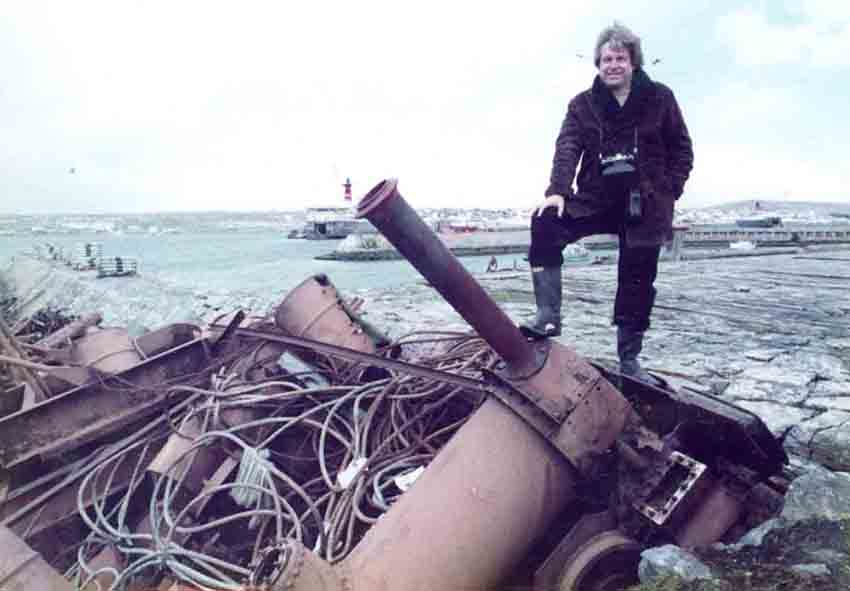I was born in Stanley, Falkland Islands, on 17 July 1935. Both my parents, and my two
grandmothers were likewise Falkland Islanders. Both of my grandfathers were English.
My paternal grandfather was born in North London, and my maternal grandfather in South
London. My maternal great grandmother was born in Bodmin, Cornwall, and was sent to the
Falklands as a very young teenager to be a servant of the Governor. My paternal great
grandparents hailed from the Scottish southwest, probably from the Kirkcudbright and
New Cumnock areas, which were at the time of their birth on the threshold of becoming
GSWR territory.
My interest in railways can hardly be attributed to them being very thick on the ground
in the Falkland Islands. The great naval Battle of the Falkland Islands, the 100th
anniversary of which was celebrated on 8 December 2014, and in which the Royal Navy
almost completely triumphed following their disastrous encounter with German naval forces
at Coronel about five weeks earlier, lead to the British Admiralty regarding the
installation of modern radio communication with the Falklands as essential, and therefore
caused a great “wireless station” to be constructed near Stanley. This was done with
commendable speed, and it was commissioned c.1916. To enable the station to be built, it
was necessary to construct a small harbour with a breakwater, on the north side of
Stanley’s natural harbour, Stanley itself being built to front the south side of the
harbour. A 2ʹ-0ʺ gauge railway was constructed from this small new harbour, which was at
a place known as The Camber, to the site of the wireless station, which was at the head
of the natural inner harbour, about three miles distant to the west. Two locomotives and
rolling stock were provided to operate the construction trains. These were Kerr Stuart’s
Wren class 0-4-0STs, builders’ numbers 2388 and 2392 of 1915. The construction of the
railway was apparently completed by late 1916.
Rapidly evolving technology soon resulted in the wireless station being outdated, and in
the late 1920s it ceased to function. Once the wireless station became inactive, the
railway became redundant. In its final working period, when loads from The Camber to the
wireless station were presumably minimal, sails were sometimes added to the rolling stock
to facilitate easy use, although this method of propulsion would probably have been of
use only to eastbound trains, taking advantage of the severe westerly winds.
Although I lived in Stanley, on the south side of the harbour, the house was in an
elevated position, within good view of the track. But I can never remember seeing a
working train on this railway, and it is said to have completely closed in about 1929.
The metal scrap from the railway, including rails, locomotives and rolling stock,
were taken to the harbour at The Camber, and pushed over the sea wall/breakwater into
the sea, but it is not known when this was done. This crude form of dumping would have
been utterly repugnant to present day sensitivities, as all the waste materials formed a
huge untidy rusting heap, half in and half out of the seawater, the level of which varied
with the tides. The photograph below shows the dump of uprooted railway equipment, plus
one of the two locomotives, the other of which is concealed by all the rubbish upon it,
as this dump existed in October 1982.
In late April 1939, when I was 3¾ years old, my parents and I left Stanley for “Home”, which was the parlance in those days for UK, on what was probably intended to be six months’ “leave”. We travelled by the local Falkland Islands Company ship Lafonia to Montevideo, in Uruguay, where I almost certainly saw my first steam locomotive, a dock shunter, and my interest in railways began. We transferred to the Royal Mail liner Highland Princess, and I can remember seeing a steam dock shunter at Santos, Brazil. We continued onward to Tilbury, and the boat train to St Pancras, probably hauled by a Stanier 3-cylinder 2-6-4T. We stayed with my maternal grandparents, who by that time had taken up residence in Slough. Whilst there, my father took me for short walks to the Uxbridge Road overbridge of the GWR mainline, about three quarters of a mile east of Slough station. The enormous number of trains on this four-track main line made a great impression, which was no doubt partly due to the clean green engines, most with copper-capped chimneys and brass safety valve covers, brass number plates, and elegant brass name plates on the named engines. Whilst in Slough, my father went to Liverpool for a few days, and my mother and I went to meet him at Euston on his return. The train he arrived on was double-headed by two Midland Red engines, one of which was almost certainly a “Jubilee”.
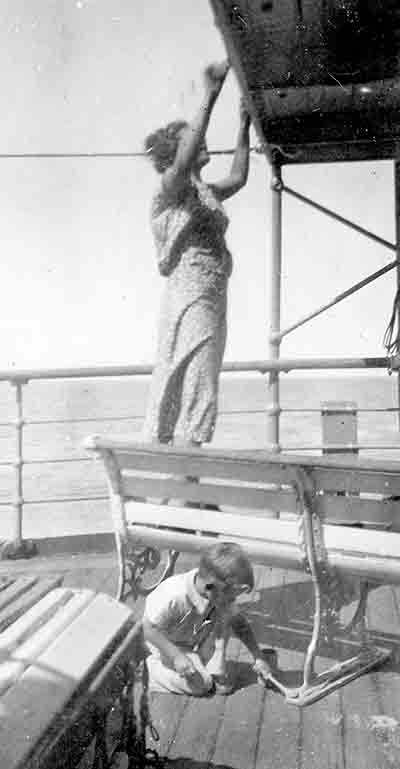
By mid 1939, the drumbeat of war was intensifying. No doubt due to this factor, to be proved only too accurate in the event, our stay in UK was curtailed by the sensible decision to leave before there were too many U-boats infesting the ocean. We departed on Highland Chieftain in late August 1939. We passed the aircraft carrier HMS Courageous in the English Channel. She was sunk by a U-boat little more than a fortnight later, on 17 September 1939, in the Bristol Channel. I personally painted much of our ship with grey camouflage paint, as is evidenced by the photograph on the left. We children of Empire knew where our duties lay! Having evaded the U- boats, and cut out a number of our scheduled ports of call, we again reached Montevideo, transferred to the Lafonia, and arrived safely back in the Falklands. Within days of my return, I commenced school. A little later, on 13 December 1939, the Battle of the River Plate took place, and the damaged German “pocket battleship” Graf Spee was scuttled on the decision of her captain. The damaged HMS Exeter made for the Falklands and was purposely beached in Stanley harbour for repairs. At about that time, my father took up the job as assistant lighthouse keeper at Cape Pembroke Lighthouse, located on what is the very eastern-most point of the island of East Falkland. Following the Japanese attack on Pearl Harbor in December 1941, it was policy that schoolchildren should be evacuated from Stanley to the settlements in “camp”, as the rural areas are known. So one evening. Probably in early February 1941, my mother and I boarded the FIC company vessel Fitzroy, and we left Stanley. Early the following morning, it being a very bright and blustery day, we were transferred to a motorboat-hauled scow, where we sat uncovered, drenched from the wind-whipped waves, which took us to the Teal Inlet jetty. There we met Jock Hall, the working manager of the station, and his son Lewis. We were taken to his house, where we were to reside for the duration of our time in.
Teal Inlet. I cannot remember a lot about that period, but my mother taught me whilst
I was there, and we went for many walks around the settlement. But all the evacuees, not
only in Teal Inlet but those in camp generally became tired of the isolated rural life,
and most returned to Stanley of their own volition, some weeks later. Our return was not
by Fitzroy, but on horseback. The overland journey is less than half the distance of the
journey by sea, probably about forty miles, over rather barren land, and including the
fording of a couple of deep creeks. I, still less than seven years old, rode with Jock
Hall on his horse, sitting ahead of him, whilst my mother was on her own horse. There
were several other riders in company with us. On the way, we stopped at each of two
“outside houses”, being the name for individual houses located a long way outside the
settlements, for “smoko”. This is the Falklands word for mid-morning tea. The houses
were The Malo and Estancia House, the latter nowadays owner-occupied by my nearest
remaining relatives in the Falklands. We then took a route to the north of Mount Kent,
and along a deep valley to Moody Brook, at the head of Stanley harbour. This was the
route of the British military advance in 1982 when moving up for the assault on Mount
Longdon, being the last and bloodiest battle of the Falklands War. When we arrived at
Moody Brook, my father, by now a member of the FIDS – Falkland Islands Defence Service -
was guarding the approach to the town by the gate in a barbed wire fence. I suppose his
commanding officer had chosen him for the purpose on this day, as it would have been
known that my mother and I were returning to Stanley.
We again took up residence in our house in Stanley, and I resumed my formal education at
the Government School. In about May 1942, British Army units, mainly of the West
Yorkshire Regiment, were sent to garrison the colony. This was on Winston Churchill’s
expressed belief, almost certainly disingenuous, that the Japanese entry into the war
would otherwise have facilitated the islands’ easy capture by them. Four soldiers were
billeted in our house, for the intervening period whilst construction of their army camp
was taking place.
The early years of WW2 were very hard for Britain, and looking back, it seems amazing that
people never ceased to believe that we would in the end emerge victorious. Nevertheless,
my mother was anxious to take up residence in UK, to which her parents had moved c.1932.
It was expected that when the war was over there would be great difficulty in securing an
early passage from the Falklands to UK. But it was thought it would be much easier from
South Georgia. So in February 1943 we again boarded the Fitzroy, as Lafonia had been sent
away to support the war effort, and travelled to the sub-Antarctic island of South Georgia,
about 800 miles southeast of the Falklands. I lived with my parents in a large house on
King Edward Point, which even had its own railway to serve it, being of 2ʹ-0ʺ gauge. It
had no locomotives, but a few wagons. This railway ran from the jetty up a steep bank
and then on flat land to serve the several houses which formed the British administrative
community, and was ideal to help the transfer of peoples’ possessions when they took up
residence.
I was to remain in South Georgia for 2½ years. We lived in a very stylish two-storey
Norwegian “kit” house erected in about 1910, which was understood to have been the
residence of the Magistrate, as the senior British officer was known, for many years. The
house had brick foundations, timber-framed walls, and a corrugated iron roof. It had a
rather grand classical entrance portico. On KEP when I arrived, and indeed in the whole
of South Georgia, there were already four children living, although the numbers decreased
during the period of my residence. There was no school. The Magistrate’s son, Eric,
received intermittent education from his parents. But I was subject to a strict,
full-time educational regime imposed by my mother, as I had in Teal Inlet, whilst the
other children ran wild. She had of course been a school teacher in the Falklands, both
in camp and in Stanley, before my birth. Nevertheless, I had the opportunity to ski and
skate during much of the winters, to catch fish, mainly of the species rocod, by line and
hook off the jetty, to go in the motor boat from KEP to Pesca (the one remaining active
whaling station during the war) every Saturday morning to collect the forthcoming week’s
rations, to chase away elephant seals when they were too near to the house, and generally
lead a free outdoor life. A postage stamp issued bearing a picture of the magistrates
house appears below followed by a picture taken in the bay at Pesca in 1984 showing the
navy vessel that provided the transport.
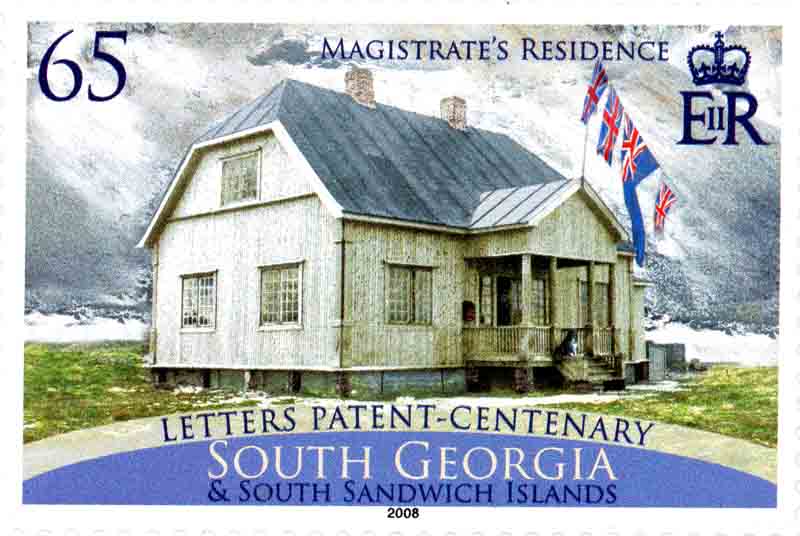
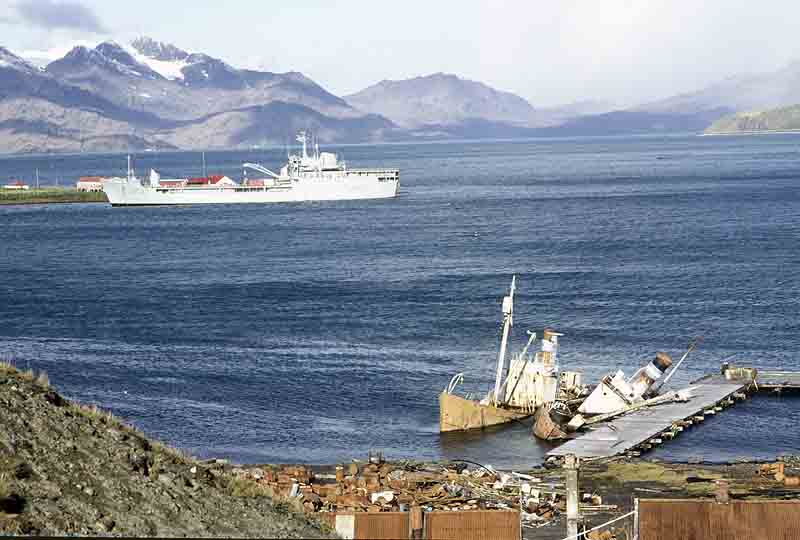
The whaling station at Pesca was served by two elderly cargo ships, each of which visited
twice a year. They carried away the whale oil production, some I think to UK, but mainly to
the USA during WW2. The first ship, Harpon, was a German-built freighter of 1902, and is
referred to again later. The second was the Ernesto Tornquist, an early floating factory
ship converted for carrying cargo and whale oil. The whaling season was in the summer
months, and these ships were also used to rotate the large whaling station population
during the season, to over-winter in Buenos Aires. Employees of the whaling station were
normally Norwegians in whaling operational roles, including crewing the whale catchers,
but Argentines and others in supporting roles. In peacetime the Norwegians were taken to
Norway to over-winter, but during WW2 they had to be content with taking their hols in BA.
In addition to the total four visits per year from the above ships, the Fitzroy made an
annual visit from the Falklands to South Georgia, normally in February, thus providing a
fifth means of contact per year between South Georgia and the outside world.
We had been in South Georgia for over two years. VE Day on 8 May 1945 had come and gone,
and we were almost upon VJ Day. A few days before that, my mother and I departed on the
steamer Harpon to Buenos Aires, and thence the Mersey. My father had to work at South
Georgia for a further year, to complete his contract. It was dark when we departed from
Pesca on Harpon, but when we passed King Edward Point, the lights were on in our house,
and my father was standing silhouetted in the front doorway, waving us off. Within two
weeks, the house was destroyed by fire, although luckily by then my father had moved out,
and our possessions had all been relocated.
The voyage on Harpon to Buenos Aires was delayed by severe storms and ship’s engine
trouble. It took about eleven days to reach Buenos Aires, whereupon it was decided that
repair work to the engine should be done. We were therefore in Buenos Aires for a month,
before setting off for Liverpool, via Rio de Janeiro and the Cape Verde Islands.
As we proceeded northwards, the balmy tropical days gave way to the inclement weather of
the Bay of Biscay, and one gloomy morning the southeast corner of Ireland became visible.
The following morning I awoke to find that we were anchored in the “roads” in Liverpool
Bay, off Wallasey, where arriving ships had, in those days of enormous seaborne traffic
to Liverpool, to wait for their berth in their intended dock. About a dozen ships were
waiting, including a liner which was obviously either the Georgic or Britannic, probably
ending its first homeward voyage with military personnel since conclusion of the Japanese
war. There were also a couple of Swedish ships, almost certainly new, and effeminately
resplendent in pastel colours, whose cleanliness and appearance was in contrast to that
of the British ships, where all were marked by the rigours of war. Shortly we proceeded
upstream and when level with the Liver Building, two modern destroyers passed us, outward
bound. I recognised the view of the Liver Building as it was used as a background
setting by many pre-war shipowners when displaying advertisements and producing postcards
of their latest ships, generally outward bound and flying the Blue Peter.
Harpon continued upstream to the furthermost docks on the Birkenhead side of the Mersey,
being Bromborough Dock, where we entered and tied up by early afternoon. The small number
of passengers on Harpon, probably only about twelve, were provided with a double-decker
Ribble bus to take us to Liverpool Lime Street station, to catch the 5.25pm train to
Euston. This was traditionally the fastest up train of the afternoon. Edge Hill mpd (8A)
was allocated a number of “Princess Royal” class pacifics which were mainly used on the
fastest London turns. One of these locomotives was 6202, the well-known “Turbomotive”,
which is known to have been frequent power on the train concerned. But of course being
a unique locomotive with unique parts, it inevitably spent much of its life in Crewe Works,
awaiting spare parts for its repair. I do not remember seeing the locomotive on this
occasion, even on arrival at Euston, and so I do not know whether it was the “Turbo” which
hauled us.
On arrival at Euston, some relatives from Slough had come to meet us. I glanced across
the taxiway to the train on the next platform. It was headed by a vast filthy object
which was obviously a streamlined “Coronation” class pacific, but without a trace of
lining visible. We got an Inter-Station bus to Paddington. These buses, which were
normal London Transport ST and LT type double-deckers, were painted a medium blue colour,
were operated by London Transport. Their purpose was understood to be the transfer of
many people, including military, between the capital’s main line stations, during the
hours of the night when the Underground was not working. From Paddington, we caught a
late evening local train to Slough, no doubt hauled by a 6100 class 2-6-2 T.
My mother and I then lived in Slough with my grandparents until late November 1946. I
went to Thomas Gray School, a primary school, which was located a few hundred yards
northwest of Slough station. After my initial introduction to the school, I had to walk
to and from it every day. The distance was about a mile, and included walking over the
Wexham Road railway overbridge, thus inevitably seeing a number of trains every day,
mainly in the morning. 1946 came, and as the hours of daylight lengthened, my dalliances
near the GWR mainline tracks increased. Most mornings the passage of an up commuter train
beneath the Wexham Road bridge was noted, hauled by mogul 6363.
At the end of the 1945-1946 school year, I passed the 11 plus exam at Thomas Gray School,
and it was arranged I go to Slough Grammar School when the September 1946 term started.
Meanwhile my father, who had worked out his time in South Georgia, arrived in Britain,
probably in early July. I think he came on Southern Harvester, a factory ship of
Salvesons, which company had been very quick to recommence their whaling operations in
the southern ocean following conclusion of the war in Europe. We went to meet him at
Euston, and his train, almost certainly from Liverpool, arrived at the same platform as
his train with the Red engines had arrived at in 1939. But this time I hardly noticed
the engines, which were black and filthy, and probably Black 5s.
In the summer of 1946, my mother and I made several local journeys at my instigation, by
bus from Slough to Gerrards Cross. This destination was chosen because it was not far
from Slough, and on the joint GWR/LNER (ex GCR) main line. This line carried GWR
Paddington-Birmingham trains, plus local services and freight trains, but these were far
less frequent than on the GWR main line through Slough, and had little of interest in
terms of locomotive variety which could not be seen at Slough. My main interest was to
see for the first time some LNER engines, and this I did, although these also were not
very numerous. Traffic at that time did of course include long-distance passenger trains
to Leicester and points north thereof, of which I saw none; freight trains generally, of
which I noted 01 class 2-8-0s and an ex GCR J11 class 0-6-0; and outer suburban services
from Marylebone to Aylesbury, the latter of which were worked by ex GCR 4-6-2Ts of the
LNER A5 class.
My parents were shocked at the severe increase in house values around Slough, and
presumably throughout Britain generally, in the period following the war’s end, where the
property market was no doubt very active with the homecoming of millions of demobbed
servicemen. They found that they could not afford a house in Slough, which had been the
intention. My father went to live in Ashford, Kent and made re-acquaintance with an
elderly uncle, who was very knowledgeable of the property market in that area, and had
considerable contacts due to his work with the KWAC (Kent War Agricultural Committee) for
several years. My father found a house to buy, and my mother and I travelled from Slough
to Ashford to take up residence late in November 1946.
To travel from Slough to Ashford, we did of course take the train from Slough to
Paddington, the Underground from Paddington to Charing Cross, and the SR from Charing
Cross on the 1115 train to Ashford. I had until then not seen a southern locomotive,
other than S15 508 on a freight somewhere near Staines, when a double decker bus within
which I was sitting at the front of the top deck was held at a level crossing for it to
pass. The S15 was black and had smoke deflectors, and I was very impressed! But on this
day of travel from Charing Cross to Ashford, our train was headed by the then very new
“West Country” class pacific 21C129, later to be named Lundy. The journey was
unremarkable, but Schools class 926 Repton, in black livery, was waiting to depart from
the up platform at Ashford as we arrived. I cannot recall what other trains I saw on the
way to Ashford, other than at Headcorn, where a K&ESR train was standing in the platform
on the south side of the main line, headed by an ancient steam locomotive which was
probably that company’s own, as it did not seem to be identifiable in the SR ABC. This
was on a Saturday, and I duly commenced school at Ashford Grammar School on the following
Monday.
I was to live in Ashford for over eleven years, and attended Ashford Grammar School for
the first five of these. The school was located on the Hythe Road, adjacent to the line
from Ashford to Canterbury West and Ramsgate. There was roughly an hourly service of
trains each way. Frequent performers were the ex SECR J class 0-6-4Ts, although the picture
below is of one of these locos. approaching Ashford from Maidstone East. There were only
five of them, built immediately before WW1 to handle London outer suburban traffic, but
soon bumped from this task by the rapid progress of SR post WW1 suburban electrification.
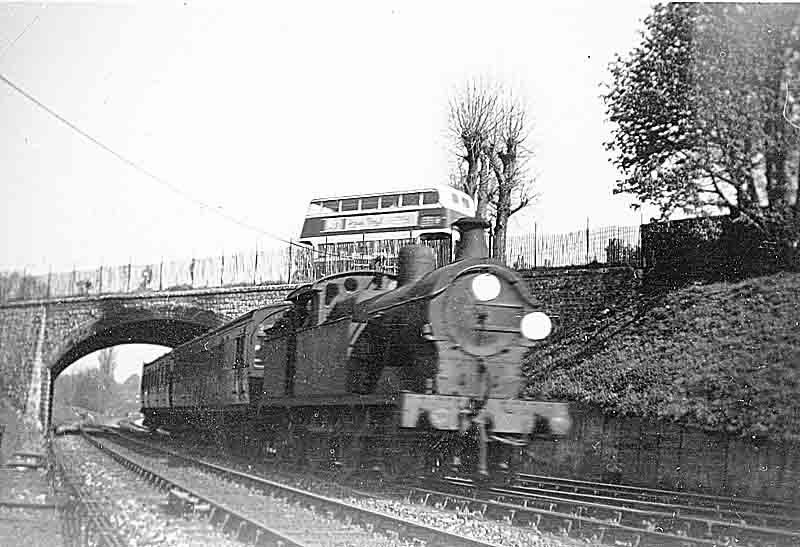
A former SECR class J 0-6-4T heads a local passenger approaching Ashford from Maidstone
The variety of locomotives working the Canterbury line, and in and through Ashford
generally, was enormous. Apart from the Js, it included the H class 0-4-4Ts, the D and D1,
E and E1, and L and L1 4-4-0s, N, U and U1 moguls, C and Q1 0-6-0s on freight, “Schools”,
“King Arthurs” and WC light pacifics. “Merchant Navy” pacifics returned to the Eastern
Section for the first time after a brief wartime introduction, when the “Night Ferry” was
reinstated after WW2, probably in 1947. In spite of Bulleid’s boast regarding the
capabilities of his locomotives, it was not long before it was recognised that this heavy
train of Wagons Lits stock required piloting, for which D1s or E1s were provided. The
“Merchant Navies” were repainted in BR blue livery in early BR days. Other locomotives
working from Ashford, but not on the Canterbury line, were the ex LB&SCR D3 0-4-4Ts
dedicated to the New Romney line. Occasionally an ex LB&SCR B4X 4-4-0 worked into Ashford,
presumably from Redhill. Ashford mpd, to be coded 74A by BR, was also host to other
oddments, including “Terriers” to work the K&ESR, Stirling 01 class ex SER 0-6-0s, one of
which daily shunted Ashford West goods yard, and also SE&CR P class 0-6-0Ts and ex LSWR B4
class 0-4-0Ts which normally shunted at Dover. Also to be seen were R1 class ex SER
0-6-0Ts, the original Stirling cab variety of which worked the Canterbury & Whitstable
Railway branch, which had a very narrow tunnel, and all varieties of which banked the Boat
Trains on the Folkestone Harbour branch; ex LC&DR 0-4-4Ts, of R and R1 classes, which
normally worked in North Kent but came to Ashford for repair, and whose classification
confused them with the SER engines. Also in these early post war years, WD 2-8-0s were in
common use in the area. Until their demise c.1949, the Stirling SER B1 and F1 4-4-0s made
occasional appearances, if only to be scrapped. The fourth variety of moguls, the
“Woolwich” N1s, which were 3-cylinder engines, the smaller diameter of which enabled them
to achieve the narrower clearances necessary on the Tonbridge-Hastings line, also
appeared, if only for works visits. Likewise the W class 2-6-4Ts, also a Woolwich
derivative which worked cross-London freights, came to Ashford for works visits. A single
Z class 0-8-0T was allocated to Ashford for shunting purposes from about 1949.
In August 1948 I was astounded to see an LMS Ivatt 2-6-4T working a lengthy special train
from Ashford, past the present site of Chart Leacon Works, towards London. I knew nothing
then of probable plans, to be effected a couple of years later, to produce engines of this
type at Brighton. They were to work local trains on the Eastern and Central Sections of
the by-now Southern Region, to enable scrapping of elderly SE&CR and LB&SCR types.
I assume now that this train, the locomotive of which I think was 42199, was a test train
prior to the construction of more of these engines.
As the 1950s dawned, fourty Ivatt designed 2-6-4Ts of late LMS type were built at Brighton.
Some were based on Ashford mpd, and took over many of the local passenger workings on
Maidstone East and Canterbury lines. Two new BR standard “Britannia” pacifics, 70004
William Shakespeare and 70014 Iron Duke were allocated to Stewarts Lane, and took over
the "Golden Arrow" and other continental workings. Although the “Britannias” gained much
respect throughout the country as competent engines, their replacement for the previous
Bulleid “West Country” pacifics, whose flamboyant liveries and very large Golden Arrow
symbols were very impressive, seemed a bit retrograde for the image of this famous train.
Apart from the “Britannias”, the other type of standard BR locomotive to be introduced to
the area was the 75000 class of 4-6-0s, of which about five were allocated to Dover, and
seemed to be used mainly on van trains, probably loaded with continental produce. In about
1955, a small number of the post-war LMS Ivatt Class 2 2-6-2Ts were allocated to Ashford,
and made further inroads into the remaining pre-grouping locomotives on local trains.
It is therefore rather surprising that with the exception of the J class, the influx of
LMS designs did not lead up to this time to the complete cessation of work by the old
SE&CR types, although the days of the D class 4-4-0s were almost over. To bring the
final steam era locomotives changes in the area up to date, the rebuilding of all the
“Merchant Navy” pacifics, and about half the WC/BB light pacifics, to rid them of their
Bulleid freakishnesses, was carried out. This lead to some reallocation of the light
pacifics, with original ones being repatriated to the West Country in exchange for
rebuilds to work the Kentish lines. The rebuilds had slightly heavier axle loading than
the originals, which were deemed by the civil engineers concerned as being unacceptable
on some West Country routes west of Exeter.
In 1946, in east Kent, there were several short lines which were subsequently closed.
These included the Canterbury and Whitstable Railway, running from Canterbury West to
Whitstable on the Thames estuary, the K&ESR already mentioned, which ran from Headcorn on
the Mid Kent line to Robertsbridge on the SE&CR London to Hastings line, the SE&CR
Appledore to New Romney branch off the Ashford-Hastings line, which remains open today as
far as Lydd and Dungeness to carry the nuclear flask trains, the SE&CR Sandling
Junction-Hythe branch (which as originally built continued to Sandgate, which length was
closed c.1931) and the ex SE&CR Elham Valley line between Canterbury and Shorncliffe,
near Folkestone. The northern length of this line was closed early in WW2, and the
southern length shortly after the war. It was built to full main line double track
standards by the SER to prempt the then-competitive LC&DR constructing their own line to
give them access to Folkestone. They need not have bothered, as the amalgamation between
SER and LC&DR to form SE&CR must have taken place almost as soon as the line was built,
and it had a very short life of about fifty years serving a rural area with a very limited
timetable. Another line, which was closed in 1960, was the single-track Paddock Wood to
Hawkshurst branch, although this was somewhat outside the ambit of Ashford locomotive
activities, being worked by H class 0-4-4Ts from Tonbridge mpd.
The other “private” line in east Kent, quite distant from Ashford, but having some effect
on its freight traffic, was the East Kent Railway. This line branched off the LC&DR
Canterbury East to Dover line at Shepherdswell. Its main function was to serve the
nascent east Kent coalfield, and connect it to the main system. Activities in this small
coalfield burgeoned in WW1, as the Royal Navy Dover patrol was based on Dover, its purpose
being to engage any German shipping, Navy or otherwise, which attempted to pass through
the English Channel. Dover, with its large modern harbour surrounded by concrete
breakwaters, was no doubt an excellent base for the cruisers used for this “patrol”, as
when not at sea they could nestle against the inside face of the breakwaters, and be well
protected from torpedo attack. The RN policy, formulated at about this time, of replacing
coal by oil fuel would not have percolated down to the smaller ships during WW1.
Therefore to expedite the coaling of the ships from the east Kent coalfield, a lengthy
overhead cableway was constructed over the Downs from the pits to the harbour. But this
coalfield remained working until the late 1980s, long after the requirement for the Dover
Patrol had had become history, and the cableway was abandoned. One of the coalfield’s pits
was Chislet Colliery, more accessible than most to the main line railways, and not
accessible to the EKR. Chislet was about three miles beyond Sturry, which is itself the
first station beyond Canterbury on the Canterbury-Ramsgate line. In peacetime, most of
its production was removed by coal trains on the line to Ashford, and thence westward.
The trains were heavy, and normally hauled by N class 2-6-0s, although below U1 no. 31896
runs through Ashford station with one of these.
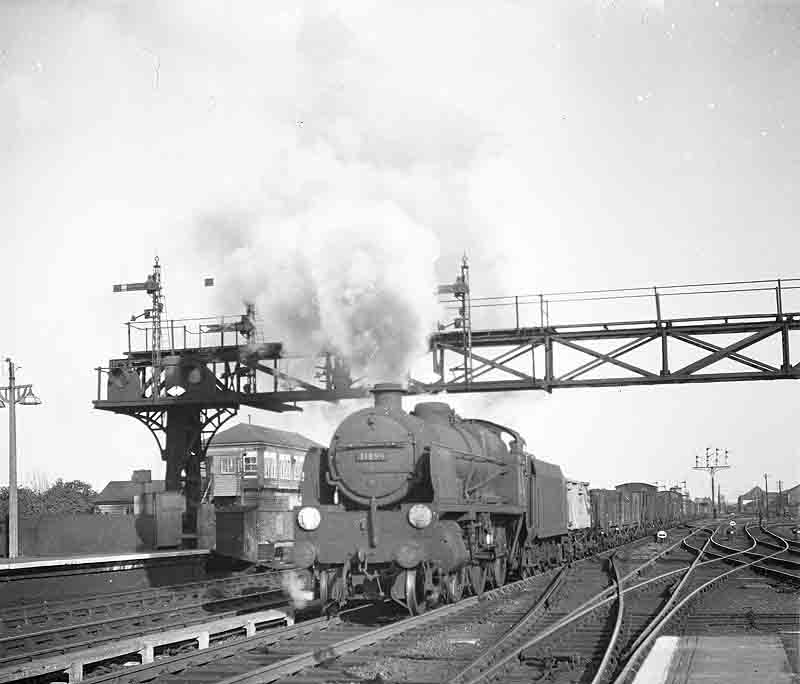
Ashford Works, the main works of the SER, was established on the south side of the main
line, in the fork of the Dover and Hastings lines, in 1847, and repaired all ex SER and
ex LC&DR locomotives, as well as all SR moguls and W class 2-6-4Ts. Although many
“Schools”, “King Arthur” and Bulleid pacifics ran in Kent, repairs upon these locomotives
were carried out at Eastleigh. The works celebrated their 100 years of existence late in
1947, when I was able to inspect the facilities as part of an organised tour, from which
most participants detached themselves and did their own thing! The Southern Railway
produced a book “Ashford Works Centenary, 1847-1947”, a copy of which I obtained on that
occasion.
After the works were built, until WW1, it built almost all new SER and SE&CR locomotives,
but in the final pre-WW1 period the railway urgently wanted what was to become its final
class of 4-4-0s, the L class. These were needed for the 1914 services, but Ashford was
not able to produce them as it did not have the capacity at that time. Borsig of Berlin
was awarded the contract, and delivered the locomotives very shortly before the then
unanticipated WW1, but they came in time to support the British logistic effort in
carrying soldiers to the Channel ports for the conflict.
Towards the end of WW1 Woolwich Arsenal was adapted to build steam locomotives, in the
hope that post-war requirements would enable the factory to remain in production and
retain workers. Woolwich produced the Maunsell designed N class moguls, and the SR
purchased and assembled kits of parts for N class locomotives. Subsequently Ashford built
N1, U and U1 classes pre WW2. During WW2 Ashford built members of the W class 2-6-4Ts,
many of the Q1 0-6-0s, and 10 of the Stanier 8F 2-8-0s. No new steam locomotives were
built after WW2.
In 1958, Brighton works was closed, and the repair of most ex LB&SCR locomotives was
transferred to Ashford. Thus in addition to the innumerable classes recorded earlier in
this chapter, locomotive types A1X, C2 and C2X 0-6-0s, D3 0-4-4Ts, E2 0-6-0Ts, E3, E4,
E4X, E5, E5X, E6 and E6X 0-6-2Ts and K 2-6-0s appeared at Ashford for their regular
repairs, together with the SR Q class 0-6-0s. This brought the total number of locomotive
types to be seen at Ashford on a normal day to about forty. This figure takes into
account the deletion of the few classes which had become extinct early in the post WW2
period, and the additions of several more types which were not introduced to the area
until a little later.
Ashford mpd is understood to have been incorporated within the works complex, in the space
between the buildings and the Dover main line, up until c.1931. It must have been very
cramped, which is no doubt why a spacious new mpd was then provided on undeveloped land in
the fork of the Dover and Canterbury lines. The ten road shed building was a conventional
“longhouse” reinforced concrete structure, and the coaling facilities were as usual on the
SR, being an embankment which loaded wagons were pushed up on, with manhandled trolleys
which had to be filled with coal and pushed to be discharged into the locomotive tenders.
This coaler was adjoining a public footpath, about half a mile from Ashford Grammar
School, and had its uses during lunch breaks, as it was possible to climb the embankment
on its non-operational side and oversee from a high level the locomotives on shed, whilst
being screened by the coal wagons, and thus not apprehended. Ashford’s allocation in
about 1948 included D, L and L1 4-4-0s, and H 0-4-4Ts, D3 0-4-4Ts, and J 0-6-4Ts for local
trains, 01 0-6-0s for shunting, C 0-6-0s, N 2-6-0s and WD 2-8-0s for freight workings,
and several “King Arthurs” of the final series for miscellaneous purposes. Neither
“Schools” nor pacifics were ever allocated there, and in the late forties, were rarely
seen on shed. But of course many of the innumerable types which came to Ashford for works
visits were to be seen there, and on an everyday basis. Us, U1s, D1s, Es, E1s and Q1s were
also to be seen on shed between their normal workings into Ashford. The shed yard is seen
below on 18/6/1961 with a pair of class C 0-6-0s visible along with "Battle of Britain"
class 4-6-2 no. 34061 73 Squadron.
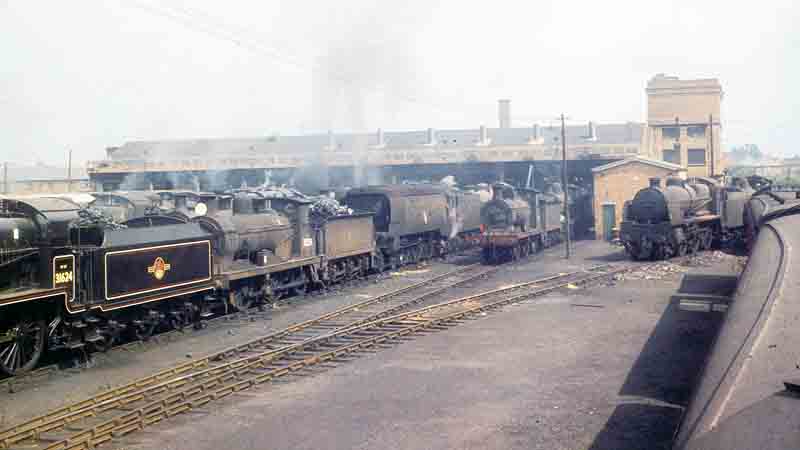
One day in about 1948, I was surprised to see a GWR Dean Goods 0-6-0 on the “dead road” on
the south side of Ashford mpd. I thought at the time that it must have been a WW2 WD
locomotive, being returned to Britain. This was almost certainly correct, as 108 members
of the class were requisitioned by the WD in WW2 as opposed to the 32 by the ROD in WW1.
24 of these engines served in both conflicts.
From WW2 until the commencement of works for the mid Kent electrification in the late
1950s to 1962 period, Ashford station consisted of two through platforms, capable of
taking trains of about eleven coaches, plus two bay platforms at the east end, which could
hold only shorter trains. Between the through platform lines were two through roads.
The main function of the latter was to take Boat Trains bound for Folkestone and Dover and
return, plus odd specials such as those for Folkestone Race Day, plus freight traffic.
The through platforms accommodated all the mid Kent line trains, plus those to and from
Maidstone East, and some of the Canterbury line trains. The bay on the down side
accommodated the remaining Canterbury line trains, whilst the bay on the up side
accommodated all Hastings and New Romney line trains, both up and down.
The station was little altered during the WW2 to late 1950s period. It is assumed that it
had had a major upgrading in early SR days, but in 1947 still had a steel footbridge,
undoubtedly of pre-SR vintage, linking up and down platforms at its west end, as well as a
generous pedestrian tunnel linking the same two platforms, which was probably a more
modern SR installation. At the west end of the platforms was the Beaver Road overbridge,
carrying a main road from Ashford to the urban area of South Ashford, and onwards to
Romney Marsh and Hastings. The steel footbridge was demolished c.1948. The main road
bridge was an unusual four-arch brick bridge with one track per arch. This bridge was
demolished and rebuilt in the late 1950s with a more conventional single-span structure,
no doubt in preparation for the mid-Kent electrification project, which was completed in
1962. In conjunction with that electrification, the two bays were extended to form
through lines. The station layout then remained undisturbed until the advent of HS1,
which brought major upheaval, which is beyond the scope of this narrative.
Passenger trains at Ashford in the steam era between WW2 and electrification consisted
firstly of the most prestigious workings, being the Continental Boat Trains, from London
Victoria to Dover and Folkestone Harbour. Most Boat Trains, including the most
prestigious of all, the Golden Arrow, and the Night Ferry, travelled via the Mid-Kent
line, although some travelled via the Maidstone East-Ashford line, presumably at times
when they were late due inclement weather in the English Channel, or some form of
disruption on the continent. The Golden Arrow consisted of wholly Pullman stock, the
Night Ferry wholly of Wagons Lits stock, and the remainder of these trains were of normal
stock but with a single Pullman car. None of these trains were scheduled to stop at
Ashford. Apart from the Night Ferry, which was “Merchant Navy” hauled, they were
invariably hauled by light pacifics until the advent of the “Britannias” c.1952, at which
time Stewarts Lane mpd received two of the latter for working the Golden Arrow. In the era
prior to the arrival of the “Britannias” a Bulleid light pacific is seen heading the train
in the Ashford area.
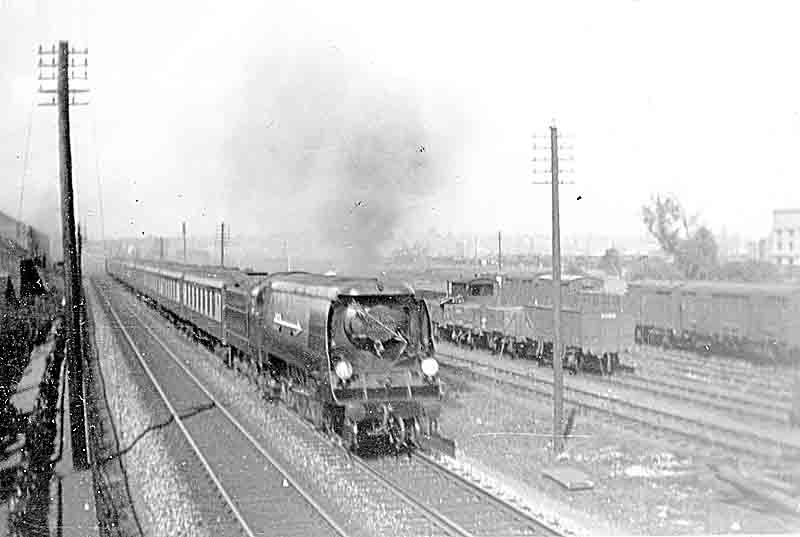
Main Line services on the Mid Kent line consisted of Charing Cross to Ramsgate via Dover
trains, mainly of about ten or eleven cars, together with Cannon Street to Ramsgate via
Dover peak hour trains. The latter included the 0824 up train to Cannon Street, where it
arrived at 0930, and its balanced down working, being the 1656 from Cannon Street. This
train and many others were mainly hauled by Bulleid pacifics, together with “Schools” and
“King Arthurs”.
Local passenger services on the Mid Kent line were normally worked by ex SE&CR 4-4-0s of
various types, occasionally by Maunsell moguls, and often by “Schools” and “King Arthurs”.
Tank engines were never used.
The Ashford-Maidstone East line occasionally saw Boat Trains diverted from the Mid Kent
line hauled by Bulleid pacifics. Otherwise the only passenger trains were locals, hauled
by J class 0-6-4Ts and H class 0–4-4Ts, until all the Js were scrapped in late 1951, and
the activities of the Hs were reduced due to the availability of the new LMS designed
2-6-4Ts.
The Ashford-Canterbury-Ramsgate line had the greatest variety of all inasmuch as
locomotives on passenger services were concerned. These will be described later, in
conjunction with my years commuting from Ashford to Canterbury 1951-1956.
The final line out of Ashford is that to Hastings, with its branch off to New Romney from
Appledore. Both carried only local passenger services. In the late 1940s, Hastings trains
were worked predominantly by H class 0-4-4Ts, and D, L, and L1 4-4-0s. It was only c.1956
that “Schools” class appeared on these trains, no doubt due to St Leonards mpd locomotives
having been bumped from the London turns by the then newly introduced flat sided 1001
series “Hastings line” dmus. The New Romney trains were unusual in that Ashford mpd had
four ex LB&SCR 0-4-4Ts of the D3 class, dedicated to these services. The services from
Ashford to Hastings on one hand, and to New Romney on the other, were normally operated
as separate trains. A Hastings bound train is seen standing in Ashford station around the
time of nationalisation headed by L class 4-4-0 no. 1768.
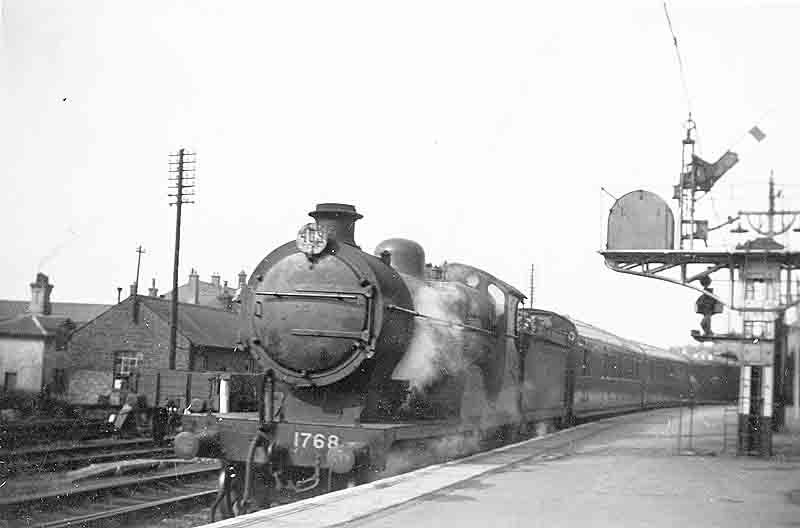
Freight trains in the late 1940s through Ashford were not numerous. They consisted of van
trains from Dover via the mid Kent line, presumably carrying imported continental produce,
coal trains from Chislet Colliery, and a modest amount of general freight. The latter was
often sorted in the yards east of the station, on the north side of the line, and resulted
in a daily train to Ashford West yard, generally hauled by one of the antique Stirling 01
class 0-6-0s, which then spent the day shunting in this yard. A London-bound train was
normally made up in the west yard daily, and set off via the Maidstone East line at about
2200. This route was probably determined due to the layout and position of the west yard.
It would have been very difficult to have run this train via the Mid Kent line, as it
would have involved complicated reversal movements to gain access to the latter.
It may be thought that the great variety of trains in the Ashford area would have
satisfied the interests of any railway enthusiast, but I was never satisfied. My mother
and I continued making periodic visits to Slough, and one sunny day, probably in 1947, a
friend and I decided to visit Feltham. Feltham yards, some of which were humped, and
Feltham mpd, were constructed on greenfield land, I think in the early post-WW1 era, in
order to rationalise LSWR/SR freight interchange traffic with the other railways, and to
render redundant some very antiquated yards adjacent to the LSWR main line into Waterloo.
We took a bus from Slough to Staines, and an emu for Feltham, which is two stations to the
east. We had a rather lengthy walk via two main roads to reach the west end of the yards,
which were themselves about a mile or more from Feltham station. We descended from the
main road overbridge at this point, to track level. This western end of the yards were
presumably not humped, to judge by the choice of motive power working them, which were
ancient Adams LSWR “duplicate list” 0395 class 0-6-0s. We walked eastwards along the full
length of the yards, and to the shed building, which was to the south of this point.
We then proceeded with the normal surreptitious tour of all the longhouse shed roads, and
as normal locospotting practice, noted all the engines present. Unfortunately I have kept
no record of these. But they included many H15 and S15 4-6-0s, together with a single
“King Arthur”; most of the T14 “Paddlebox” 4-6-0s; all four G16 4-8-0T hump shunters;
four of the five H16 4-6-2T interchange freight locomotives; Q1, 700 and 0395 0-6-0s; a
T9 4-4-0; and a T1 0-4-4T of the type whose numerical sequence started with Southern
Railway no. 1 in the ABC. Mission accomplished, we returned to Feltham station, and caught
an emu back to Staines. At the intermediate station of Ashford Middlesex, an eastbound
freight train had been brought to a halt. It was headed by another T14, the late
afternoon sun glinting on its clean and exotic form. Oh for a camera, which at that stage
of course I did not have. In a much later view on 18/3/1964, class S15 4-6-0 number 30823
stands on the left in Feltham shed yard with W class 2-6-4T nos. 31914 and 31912
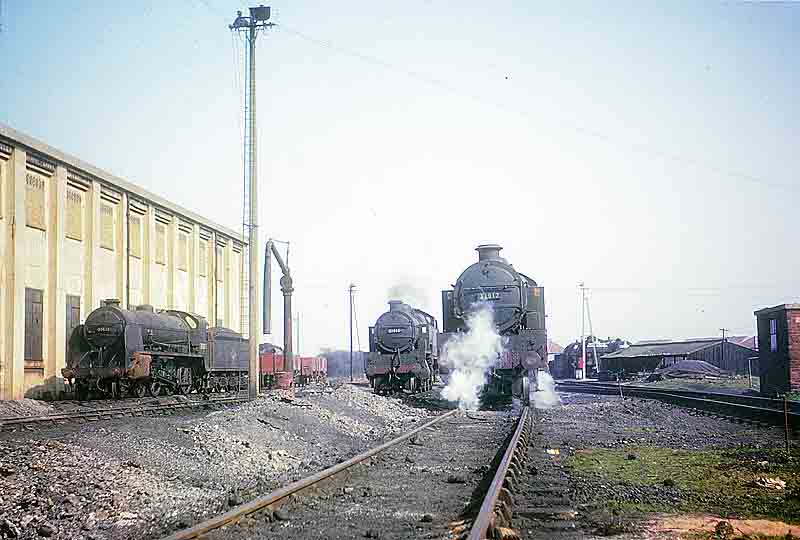
In the summer of 1947, an uncle from the Falklands visited my family in Ashford. He had
to go to London for a day, and knowing my railway interest, offered to take me, and leave
me for a time on my own at the above termini. I went to Kings Cross first, where I saw my
first Gresley pacifics, including number 6 Sir Ralph Wedgewood in blue livery and 55
Woolwinder, of course in apple green, together with N1 and N2 0-6-2Ts. I then walked
across to St Pancras, which never seemed very busy, and saw a “Jubilee” plus the normal
collection of Black 5s, and Fowler 2-6-4Ts and 2-6-2Ts. I finished at Euston, where I
saw an original “Royal Scot”, a “Princess Royal” and other lesser locomotives.
After we had moved to Ashford, my mother naturally made visits to my grandparents in
Slough, upon which I normally accompanied her. We made such a visit a few days before
New Year’s Eve of 1947. Requested by me, we took a bus to Watford on 31 December, and I
went to Watford Junction station for a couple of hours in that short afternoon. The mpd
is on the up side of the line, slightly to the north of the station. There were various
LNWR 0-8-0s and MR 0-6-0s on shed, as well as the normal suburban 2-6-4Ts. But of course
I went to see LMS long-distance trains, which I had never before seen on the move. I was
rewarded with the sight of 6243, still streamlined, on an up express, and the inevitable
“Jubilees”, “Royal Scots” both original and rebuilt, and Black 5s, on fast trains. But
the incident which most remains in my memory is of a northbound express hauled by an
original “Royal Scot” entering the down platform at high speed, whilst a railway worker
casually attended to some form of repair whilst crouching in the four-foot. He seemed to
be totally oblivious of the approaching “Scot”. I screamed at him to move, which he did,
seemingly at a speed to suit his own convenience, without accident.
Very early in 1948, when visiting Ashford mpd, I was surprised to see 21C170 Manston on
the coaling road. This type of locomotive rarely entered the mpd at that time, and I had
in any event not until then realised that this particular one had yet been built. I had
a Box Brownie camera of my mother’s with me and took a reasonable picture. Later I
accidently opened the camera whilst winding on, thereby allowing light in, ruining the
picture by cutting off the tender! But I learned from my mistakes.
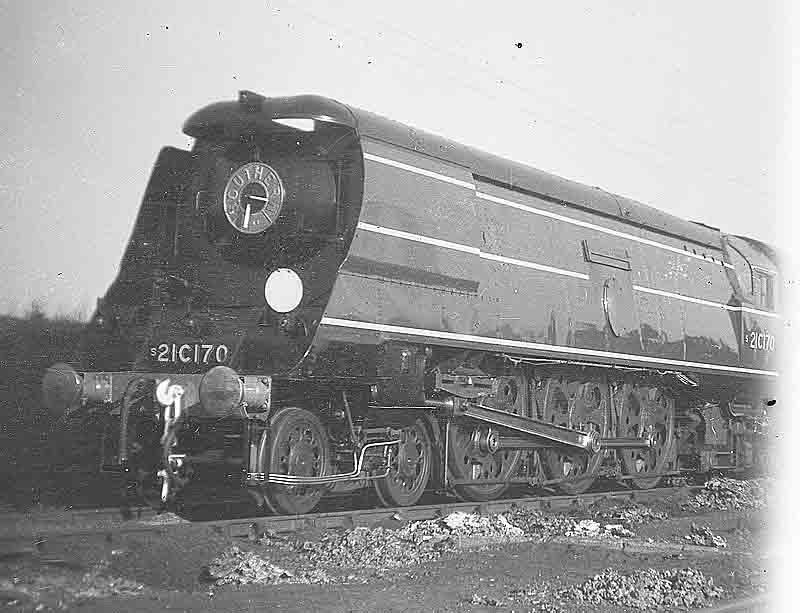
A little later in 1948, probably during the Spring half-term holiday, my mother and I
again went from Ashford to Slough, and returned to Ashford on a Windsor and Eton Riverside
to Waterloo emu , which was by now part of the Western Section of the Southern Region of
British Railways. When approaching Waterloo, a “Merchant Navy” was departing with a West
of England express. Alighting from our train in the terminus, we walked to the through
platforms of the Eastern Section lines and waited on the platform for our train to
Ashford, which I think was the 1115 down from Charing Cross. Some minutes later it
arrived, and I was surprised at what I saw. The locomotive was a light pacific in
malachite green, but its front was bland because it lacked the Southern “roundel” in the
middle of the smokebox door. It was as yet unnamed. Clearly this locomotive had been
outshopped new very recently. I have always admired the style of the original Bulleid
pacifics, which the roundel did positively enhance. It seems sad that of the large number
of this locomotive type which remain in existence on the heritage railways in 2015, only
the sole example of 21C123 Blackmoor Vale retains this feature.
I had been attending Ashford Grammar School since late November 1946, and had made friends
with other railway enthusiasts. One, named Freddy Else, had commenced fairly regular
visits to London, and elsewhere, on what was now the Southern Region, and visiting the
Southern mpds with the benefit of shed permits. He took a small group of us a couple of
times, for locospotting purposes. These visits undoubtedly enabled me to “cop” a large
number of locomotives, but leave no outstanding memories, other than, from our train,
spotting my last Brighton Atlantic, 32422 North Foreland, on a low level line beneath us
near London Bridge.
Bricklayers Arms was an utter shambles of an mpd, with locomotives housed in miscellaneous
scattered buildings, within what appeared to be a large industrial area to which the
public did not normally have access. It was interesting to note that although this was
the prime London mpd of the Eastern Section, there were no Bullied pacifics on shed.
There was a quite separate “layover point” known as Ewer Street on the north side of the
SE&CR main line near London Bridge, where the larger locomotives which brought trains up
from Kent in the mornings laid over, with some scope for servicing, before they returned
to Charing Cross or Cannon Street to couple to their down trains later in the day.
Stewarts Lane was an mpd which was on a confined site, hemmed in by a tangle of railway
lines and flyovers. It did of course supply Bulleid pacifics for the Boat Trains from
Victoria which ran through Ashford. It also had a mixture of ex SE&CR and LB&SCR
locomotives, including the E2 0-6-0Ts which shunted empty coaching stock at Victoria, and
D1 and E1 4-4-0s, which were rostered to pilot the “Merchant Navies” on the Night Ferry,
as well as being used on other services.
Nine Elms was the main London mpd of the LSWR, by now the Western Section of the Southern
Region of BR. This shed was located on a quite generously large site compared with
Bricklayers Arms and Stewarts Lane, and incorporated one of the very few mechanical
coaling towers possessed by the former Southern Railway. (Others were at Feltham, Exmouth
Junction, Stewarts Lane, and Ramsgate). Its allocation included heavy and light pacifics,
“Lord Nelson”, “King Arthur” and “Remembrance” 4-6-0s, M7 0-4-4Ts for shunting coaching
stock into Waterloo, and various LSWR 4-4-0s. After the end of steam, the activities of
Covent Garden fruit and vegetable market were transferred to the Nine Elms site, which was
obviously more suited for distribution purposes than its earlier site in the heart of
London. But it is soon to undergo a further radical change of use, and become the site of
the United States Embassy.
In the late summer of 1948, it became fairly obvious that I was unwell, and I was
diagnosed as having tuberculosis. This was a disease very prevalent in Britain during
these early post-war years. I was sent to Ashford Hospital, which was fairly near to
Ashford West goods yard, and also close to our home in Ashford. This hospital is now
closed, and is not to be confused with the William Harvey Hospital in nearby Willesborough,
which is now the main hospital for the area. For the first few days in hospital, I was in
a normal ward, and had various tests carried out. Thereafter I was transferred to a
greenhouse-like glass lean-to built against the south wall of the same ward. This lean-to
had three beds at its west end, and I was given the western-most of these, which itself
was against the glazed flank “wall” of this ward extension. I had two companions, in the
other two beds. Both of them were ex servicemen, both presumably had tuberculosis, and
both succumbed during the three months that I was to be in hospital. I had no treatment
whatsoever in the hospital after the first few days, but I gradually recovered to return
home before Christmas 1948.
The main purpose of these words concerning Ashford Hospital is that my greenhouse ward had
a perfect view, to the south west, of the Ashford-Maidstone East line, at this point
climbing steeply away from Ashford at 1 in 100. With reasonably clean engines, it was
possible to read their numbers. The local passenger services at this time remained
wholly in the hands of the H class 0-4-4Ts and the still extant class of five J class
0-6-4Ts. There were occasional freight trains, upon some of which the WD 2-8-0s, still
operative on the Southern, provided the power. I well remember one such train descending
the gradient, providing brake power rather than motive power, with major sound effects
emanating from the knocking of the rods when operating in this mode. Mr Bishop, one of my
two co-patients, witnessed this WD shortly before his death, whereupon he gave the class
the nickname of “Chonkers”, which seemed very appropriate. The only other trains to use
the line were the diverted Boat Trains, hauled by light pacifics. The earlier locomotives
in the 34081-90 series were being built and put into service during this period. I had
never seen any of these prior to my hospitalization, and I was able to cop several of them
whilst there.
By the late 1940s and early 1950s, my mother’s only brother, Reg, was still living in
Yarmouth, but by now with his wife and son. After my convalescence from tuberculosis,
they invited me to stay with them for a week in Yarmouth, which I did, I think in the
summer holiday of 1951. I travelled from Ashford to London by train, went to Liverpool
Street, and boarded a mid-afternoon train to Yarmouth. The locomotive was “Sandringham”
4-6-0 61629 Naworth Castle, and the route was to Ipswich and then via the East Suffolk
main line, which at that time remained opened throughout, to Yarmouth Southtown Station.
A memory of this journey was that of a J15 0-6-0 with a stationary up pick-up goods train
which we passed in bright early evening sunlight at a station, which was probably
Saxmundham.
The railway geography of Yarmouth did then consist of three separate lines which entered
the town. The first was the ex GER East Suffolk main line to Southtown terminus, as
already mentioned. The second was the ex GER line from Norwich via Acle to Yarmouth
Vauxhall terminus, which had a loop off it to the south via Reedham. The third was the
ex M&GNJR line from Kings Lynn and Melton Constable to Yarmouth Beach terminus. This
line had a branch theroff southwards over the GER line slightly west of Vauxhall station
and thence over a long steel viaduct over Breydon Water, to Lowestoft. This branch was
the Norfolk & Suffolk Joint Railway, presumably owned by the GER and the M&GNR, and it had
a connection on the north side of Breydon Water into the Vauxhall line. There was a goods
only branch from Vauxhall station to Yarmouth quayside.
Trains to Southtown from Liverpool Street were hauled by “Sandringham” and B1 4-6-0s, and
possibly the odd B12 4-6-0. Local trains were hauled mainly by “Claude Hamilton” 4-4-0s.
This Southtown line had its own mpd, somewhat south of the station on the east side of the
tracks. There were also local trains from Southtown to Lowestoft, over a connection to
the N&SJR, normally with ex GER 2-4-2Ts as motive power.
Trains to Vauxhall from Norwich were mainly in the hands of B1s and “Claude Hamiltons”.
There was a very small mpd near the end of the platforms, and close to the Yarmouth
Beach-Lowestoft line overbridge. Vauxhall also handled a number of holiday period extras
from the East Midlands, the stock of which could be accommodated in sidings to the west of
the previously mentioned overbridge. Vauxhall shed also supplied the small J65 type
0-6-0T which shunted the quayside branch, already mentioned.
The services to Yarmouth Beach consisted of local trains on the M&GNJR hauled by
“Claude Hamiltons”. Longer distance holiday trains were hauled, and by B12 4-6-0s and
“Claude Hamiltons”. Lowestoft trains over the N&SJR were hauled by ex GER 2-4-2Ts.
Freight trains were in the hands of J15 and J17 0-6-0s.
The railways in the Yarmouth area have been greatly reduced since this period. The East
Suffolk main line was truncated at Beccles, and Southtown station closed. The M&GNJR and
the N&SJR were completely closed c.1959, although shortly before closure, the M&GNJR
received new motive power in the form of Ivatt class 4 2-6-0s. Vauxhall station has been
the beneficiary of the earlier mentioned closures, as it is now the only station in
Yarmouth, and therefore the only one which serves London.
I was in Yarmouth for about a week, and made rail journeys to Lowestoft and Norwich.
These journeys enabled me to see all the ex GER and LNER types running, the stars of which
were the two apple green painted “Sandringhams” allocated to Norwich mpd, being 61659 East
Anglian and 61670 City of London. These two locomotives had been streamlined in the late
pre-war era to haul the prestigious East Anglian train between London and Norwich, but
were de-streamlined within the year after I first saw them.
My week spent in Yarmouth at this time was sufficiently interesting and enjoyable to go
again the following year. This time I travelled on "The Easterling", being a newly-named
late morning train from Liverpool Street, B1 hauled, which took water at Manningtree
troughs, which were the only ones on the ex GER lines. On arrival in Yarmouth, I
purchased a railway runabout ticket for the week concerned. This covered the lines from
Southtown to Ipswich and Lowestoft, from Ipswich to Norwich, from Yarmouth Vauxhall to
Norwich via the two routes, from Yarmouth Beach station to Cromer and to Lowestoft, from
Beccles to Lowestoft, from Beccles to Tivertshall, and a couple of other branches. The
main change apparent in motive power that had occurred during the interim period since my
last visit, apart from the de-streamlining of the two “Sandringhams” mentioned earlier,
was the introduction of “Britiannia” pacifics on the Liverpool Street-Ipswich-Norwich
line, and I rode behind these locomotives a number of times.
My education at Ashford Grammar School continued until the summer of 1951. I do not think
that the Headmaster had a great opinion of my intellectual capabilities, but I did
nevertheless achieve about six passes in the O-level exams in the summer term of that year.
I had no very strong ideas as to what work or professional activity I should seek to
follow when I left school, but there was a weak consensus between the Headmaster, my
mother and myself that as I was good at drawing, it might be a good thing to study
Architecture. This rather unenthusiastic choice was within the context of my then quite
recent illness with tuberculosis, which was considered to inhibit my adoption of a more
strenuous career, where I might otherwise have sought to become an officer in the Merchant
Navy.
Having regard to the above, and following an interview with the head of Canterbury School
of Architecture, I commenced my studies at that institution in September 1951. The
intention was that I should ultimately qualify and gain membership of the Royal Institute
of British Architects, which would enable me to practise as an architect in Britain, and
probably most Commonwealth countries. In that period, and for about another ten years,
the grammar school O level passes were accepted as being sufficient to commence studying
Architecture, although the requirement for A level passes came about a few years later.
It was decided that I would continue to live at home in Ashford, and make the return
journey of 14½ miles each way from Ashford to Canterbury West by rail every weekday.
Thus on 13 September 1951 I commenced this normal form of commuting. On the first day of
travel, on the morning train which was due off Ashford at 0824, was nearly-new Fairburn
2-6-4T 42070. The J class 0-6-4Ts were obviously in rapid decline due to scrapping, but
the same train on 21, 24 and 25 September was hauled by 31596, and that was it. This
class of 5 locomotives had gone! Nevertheless, the variety of locomotives hauling this
train was great, and was even more so inasmuch as my normal return train at 1702 from
Canterbury was concerned. Locomotives that I was hauled by were “Schools”, “King Arthurs”,
WCs/BBs, N, U and U1 moguls, D, D1, E, E1, L and L1 4-4-0s, H 0-4-4Ts, J 0-6-4Ts, and
Fairburn 2-6-4Ts. About 1955, LMR Ivatt 2-6-2Ts were transferred to the Southern, and
became fairly regular performers. I continued this form of commuting for four years,
whereafter I used my 1935 Morris 8 ex Post Office van for one year. After that it was
necessary for me to do an extra term, as otherwise I would not have been old enough to
take the final exams. So for this last term I reverted to rail travel. In fact I had
taken and passed the intermediate exams two years earlier, and I did take and
satisfactorily pass the final exams in December 1956.
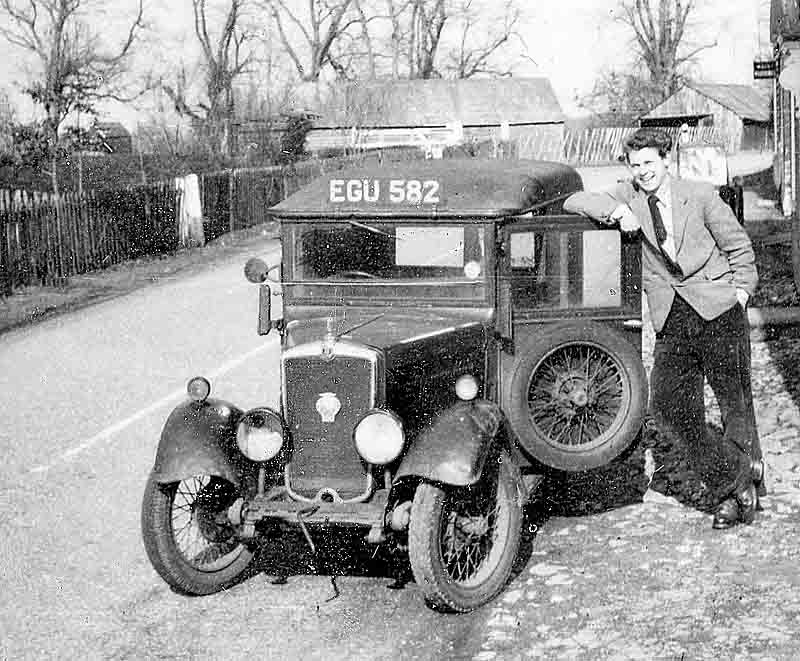
Gerald's first vehicle - a 1935 Morris 8 ex Post Office van
Back to the first year of my architectural studies, and I was determined to continue with
the activities of my railway enthusiasm. Notwithstanding that many railway enthusiasts
would have considered my residence ideal in Ashford, Kent, with its huge variety of
locomotives, I constantly wished to extend the range and variety of my locospotting visits.
An obvious “first” in this respect was to Tunbridge Wells West, I think in 1950. Its mpd,
next to the station, had an allocation composed largely of ex LB&SCR I3 4-4-2Ts, for
working the London services to Victoria. Tunbridge Wells is 32 miles from Ashford, and it
took about two hours to accomplish that distance. On this first visit, I saw several of
these elegant locomotives, although on a couple of similar later visits these had been
largely replaced by the Brighton-built Fairburn 2-6-4Ts.
Another day-trip destination by bicycle was to the North Kent line, whose locomotives were
rarely seen in Ashford. A day out would normally include a visit to Faversham mpd and
Gillingham mpd, in which rare Ds and Es often lurked. On one of these visits I
unexpectedly encountered the Bowater narrow gauge railway at Sittingbourne.
On yet another occasion I cycled by the same route to Gillingham and onwards to Gravesend,
and took the ancient ferry across the Thames to Tilbury. At this time the Stanier
3-cylinder 2-6-4Ts were in almost total control of the London, Tilbury and Southend
(ex LTSR) services. Finally, I decided to do a day trip by this same route, but to extend
it to Stratford. It was a trip too far, not improved by the fact that I went on a Sunday,
and I think the only train I saw was a “Britannia” hauled express, plus a couple of N7
hauled locals.
A final cycle tour took a friend and I, in the summer of 1951, to St Leonards, Eastbourne
and Brighton, where we visited the mpds. Whilst at Brighton, the afternoon workers’ train
from Lancing works came into the station, double headed by an SE&CR D 4-4-0 and a LB&SCR
E4 0-6-2T. In the evening we saw a K 2-6-0 hauling what was probably a London postal
train through Preston Park. The following day we went to Portsmouth and to the Fratton
roundhouse before taking the ferry to the Isle of Wight, and observed much of the railway
activity that was commonplace on the Island in that era, including a visit to Newport mpd
which at the time had Terrier and E1 0-6-0Ts on its allocation as well as the normal O2
0-4-4Ts. Returning to the mainland, we made our way to Eastleigh mpd, before spending the
night at Winchester.
The following morning we spent some time near Micheldever, and for the first time I
witnessed a “Nelson” on the move, on the long bank up from Winchester with a London train.
Although the “Nelsons” had hauled Eastern Section Boat Trains in the pre WW2 era, these
trains ceased running shortly after the beginning of the war, and by the time they were
able to resume, the Southern was in course of inundation with Bulleid pacifics. Thus
“Nelsons” never returned to the Eastern Section, except for one which hauled a freight
when going to Ashford for scrapping, c.1962. We then cycled to Basingstoke, and from
thence to Reading, where we visited the station late in the afternoon. We were standing
at the east end of the platform when a “Castle” drew in beside us with a lengthy train
from the West Country to Paddington. The fireman got off the footplate, and having an
obviously anti-spotter attitude, told us we should be doing something more active, rather
than standing around on stations. My temper aroused, I told him that we were not bloody
lazy, we had already cycled about 60 miles that day, and must likewise go on to London.
At the time I commenced studies at the Canterbury School of Architecture, it was the
policy of that institution that there should be an overseas study trip every summer
holiday, in which all the students were expected to participate. Holland was obviously
chosen because it had many quite new buildings of the immediately pre and post WW2 periods,
which were then regarded as landmarks of architectural design. We went in the 1952 summer
holiday, travelling by the elderly steamer Mecklenburg from Dover to Flushing, and most of
us, having taken our bicycles, then had to cycle 150 miles or more from there to Zaandam,
on the northern outskirts of Amersterdam. Needless to say my own interest included that
of the railways. On leaving the ship in the early afternoon, we cycled eastwards through
Bergen op Zoom, and in this area noted an active and quite modern 0-8-0. From information
I have gained years thereafter, it appears that a number of these engines were purchased
by Holland from the Swedish railways in the immediate post WW2 period. We reached Zaandam
in the afternoon of the following day, and were accommodated, within view of the station,
in a single-storey storage building in which everybody slept in sleeping bags on the floor.
This was not conducive to the avoidance of hay fever. Passenger train traffic on the
railway was frequent, most of the trains being of the then modern Dutch suburban emus of
distinctive design, but with drab livery. But there were a number of steam hauled trains,
particularly at peak hours. Holland seemed to have been an excellent market for Beyer
Peacock, who supplied all the locomotives seen, being elderly 4-4-0s and more modern
4-6-0s, on trains to the north of Amsterdam.
Not long after the above visits, I concluded that cycling was not the most practical means
of reaching the longer-distance places to which I wished to get. A friend and I decided
to visit all the North London mpds in a single day, which happened to be a Sunday. I
travelled from Ashford by train to meet him in London, and we began a great anti-clockwise
sweep through the area. We started at Plaistow (ex LTSR), then proceeded through Devons
Road (ex NLR), Stratford (ex GER) where we gained access somewhat against the odds, Kings
Cross (ex GNR) ditto, Camden (ex LNWR), Kentish Town (ex MR), Cricklewood (ex MR), Neasden
(ex GCR), Willesden (ex LNWR), and Old Oak Common (ex GWR). Why we did not go to Hornsey
(ex GNR) I know not. I do not think we saw anything very unusual during this marathon day
of visits, although the Garratts were still to be seen at Cricklewood.
Still feeling imprisoned by my confinement in the Kentish peninsula, I made plans for a
day trip to Manchester. Actually it was for a little more than a day, as the Sunday train
service from Ashford to London was almost non-existent early enough in the day to enable
me to connect with a Sunday extra from Euston to the then London Road station in
Manchester. So I had to go to London on the Saturday evening, and stay in a Youth Hostel
in Highgate. The train to Manchester, which was actually on 24 May 1953, was hauled by
46139 The Welch Regiment. It left Euston at 0935, arriving at London Road at about 1245.
I decided to visit the sheds by a clockwise route, using local buses and the British
Locomotive Shed Directory book. First I visited Stockport (ex LNWR), Heaton Mersey (CLC),
Trafford Park (ex MR), Patricroft (ex LNWR), Agecroft (ex L&YR), Newton Heath (ex L&YR),
the small ex MR roundhouse Belle Vue which was closed shortly after my visit, Gorton
(ex GCR) and Longsight (ex LNWR). The long summer day was at first dull in Manchester,
but it had soon changed to heatwave conditions. I had nothing to eat or drink all day,
until I stopped briefly for a drink in a pub on the way back to London Road, in the late
evening. The return train to Euston left at 0040 the following day, and on arrival I went
to London Bridge to catch the 0723 train to Ashford.
This visit to Manchester did not result in seeing any particularly unexpected locomotives
at the sheds concerned, but my first experience of a northern industrial city was
something which I always remember.
Following the tradition of the School of Architecture arranging “summer camp” visits to
other countries, a visit to Germany and Denmark was arranged for the 1953 summer holiday.
I do not recall much of the German part of this trip, but in Denmark we stayed in
Copenhagen for several days. Although not seeing much in the way of moving trains, other
than in the nearby main city station, the mpd was not far away. One Sunday afternoon I
went to the mpd, introduced myself to the foreman, who spoke excellent English, and asked
him if I could walk around and see the locomotives. He accompanied me on my tour of the
premises. Fortunately by this time I had brought a second hand, if not very reliable
camera, and I photographed the various locomotives seen, including P class 4-4-2 no. 919
standing in Kobenhavn station seen below.
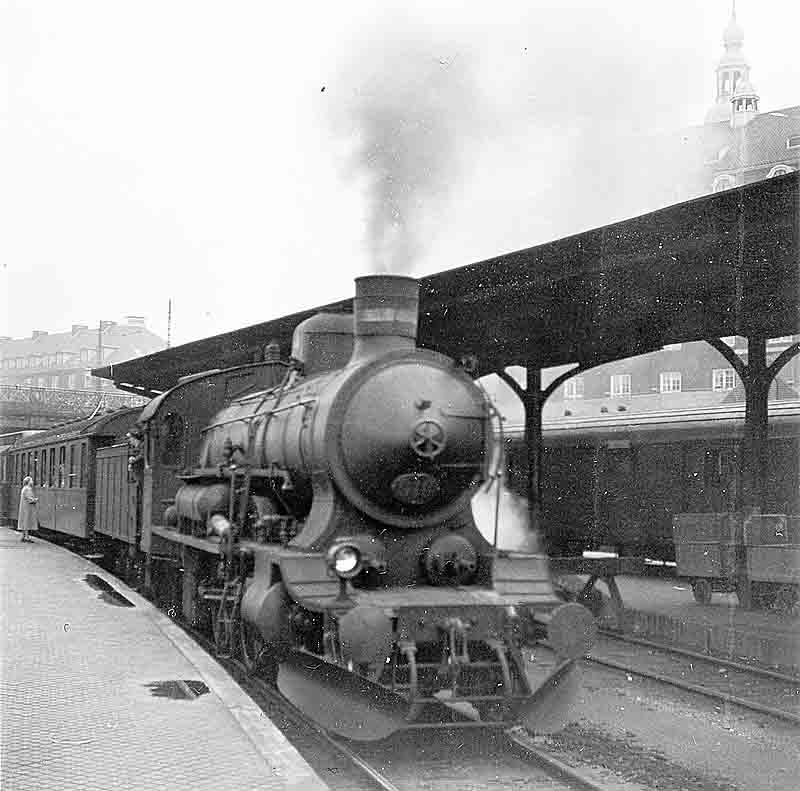
In early September 1954 I hitch-hiked to York, established myself in a bed-and-breakfast for a week, and purchased a railway runabout ticket. During the following week I used it very extensively, to travel to Scarborough, Leeds, Huddersfield, Bradford, Keighley, Halifax, Low Moor, Wakefield, Bridlington, Market Weighton, Seamer, Shipley, Queensbury, Pontifract, Manningham, Mirfield, Normanton, Ardsley, Selby, and intermediate places. I was hauled by all the locomotive types which would have been expected on the lines concerned, including B16s, Crabs, N1s, D49s, Fowler 2-6-4Ts, A1s, A4s, V2s, Fowler class 4 0-6-0s, L&YR 2-4-2Ts, J39s, class 2 2-6-0s, J6s, N7s, and Midland Compounds, not to mention the common B1s and Black 5s. This was another very interesting experience, particularly inasmuch as the West Riding was concerned, and was partly responsible for the impetus which enabled me to decide upon that area as the basis of Volume 1 of the present series - Steams Final Years.
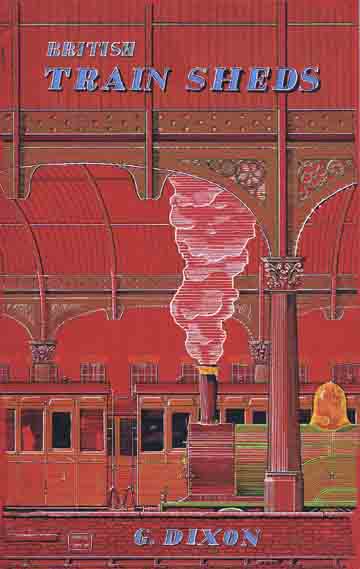
Another thesis which I had to produce was “British Train Sheds”. This term refers to the large traditional stations with overall roofs, and has nothing to do with the mpd type of shed. It was produced in book form, and a copy of the cover picture is shown on the left. At about this time, I found myself to be a little less enthusiastic about my railway interests. I continued to get and read the magazines, and every day as my train from Ashford curved away from the Dover line to the Canterbury line, I made a mental note of that day’s lineup of locomotives in Ashford Works yard, but my travels throughout the country became more limited. I now realise that the diminishment in interest related solely to the relatively juvenile pastime of locospotting. My broader interest in railways continued unabated, and well and truly revived when the use of somewhat superior cameras enabled the production of less amateurish photographs. Having successfully passed the RIBA final examination in December 1956, I had to look around for a job. I accepted an offer from Ronald Ward and Partners, whose office was in Belgravia, London SW1, and I took up my position in January 1957. I still continued to live in Ashford with my mother, who had bought a new but modest house in Willesborough, a suburb of Ashford east of the Canterbury line, with the proceeds of careful provision made by my father before his death.
Every working day I had to get to Ashford station for a
Charing Cross train, which I think departed at 0707. This train had already had a
lengthy journey from Ramsgate via Deal and Dover around the Kent coast before it stopped
at Ashford, and thereafter stopped at Tonbridge, Sevenoaks and London Bridge. It was
always “King Arthur” hauled. From Charing Cross I caught a clockwise Circle Line train
to Sloane Square, from which I walked about half a mile to the office.
To return to Ashford at the end of the day, I took an anti-clockwise Circle Line train the
somewhat greater distance to Cannon Street. As a lowly employee I was not meant to leave
the office until 1730, and thus obviously I could not get to Cannon Street in time for the
“train of the day”, being the 1656 down non-stop to Ashford. There was a slower train at
about 1750, and by leaving work only a few minutes early, I always managed to catch it,
arriving at Ashford at about 1930. As I normally sat in the back of the train, and the
exit at Ashford was level with the rear coach, I rarely had the opportunity to check for
motive power, which was again normally a “King Arthur”. Throughout most of 1957, this was
my pattern of travel, which was not without its boredom. The line from Ashford to
Tonbridge is almost dead straight, about 27 miles long, and fairly flat. In the up
direction, the heavy gradients from Tonbridge to Sevenoaks and from Dunton Green to
Knockholt, both at about 1 in 144 or steeper, include Sevenoaks tunnel and Polhill tunnel,
at about two miles and one and a half miles long respectively. In the down direction the
main gradient was much longer, from Hither Green to Knockholt, and fairly short from
Dunton Green to Sevenoaks. The line from London Bridge to Petts Wood is quadruple track.
My Ashford-bound train ran on the southern eastbound track, and there was a presumably ex
Charing Cross train for the North Kent line scheduled to pass through Hither Green at
about the same time as mine. Both trains were of about ten or eleven coaches and were
thus of about the same weight. In the vicinity of Hither Green, my train began to slowly
overhaul the North Kent line train, our relative speeds meaning that we very slowly
overtook it coach by coach, until we levelled with its hard working “Schools” class
locomotive. On light summer evenings, I had a grandstand view of it at close quarters
being thrashed as we gradually overhauled it. I have always regarded the “Schools” as
being the most excellent locomotives, and the “King Arthurs” as being of constipated
indifference, but in this context, with heavy trains on fairly heavy gradients, the
greater power of the “Arthurs” rendered them superior.
Back in the 1950s the Eastern Section of the Southern Region was the busiest suburban
railway in the country. The junction at St John’s, Lewisham, is thought to have been the
absolute busiest, with 990 trains passing through within the working day, and more than
1100 within a weekday 24 hour period.
1957 was several years before the Clean Air Act took effect, which had the ultimate result
of clearing the filth from the London atmosphere, which was caused mainly by millions of
domestic coal fires. In fact I experienced what I think was the last occasion of the
great London smogs when I was living in Colindale NW9 in the winter of 1961-1962 But four
years earlier, I went to work as normal on 4 December 1957, when the weather conditions
suggested what was to come. In Belgravia, it darkened during the day as the smog
intensified. Suspecting transport disruption, I was allowed to leave the office earlier
that day. I left a little before 1700 hrs, and as usual took the Circle Line train to
Cannon Street. When I reached the station there was a train in the platform from which my
normal train should have departed at about 1750. But it was not mine, but the down
“train of the day”, the 1656 non-stop to Ashford and thereafter via Dover to Ramsgate,
running late due to the visibility conditions. I boarded this train, and sat in the
penultimate or tenth coach, which, as most of them in those days, was of side corridor
compartment stock, in this case an SR-built 1936 vintage vehicle. In my compartment were
several people, about three aside. I sat in the middle of the front-facing seat, and
opposite me, in the rear facing seat, was an elderly woman. The train was headed by
34066 Spitfire, and departed a few minutes after I boarded. We trundled off in
pea-souper conditions through London Bridge and onward. I thought that although our
speed was far lower than it would usually have been, the driver was doing well to
maintain our actual rate in the weather conditions which pertained. I sat back and
briefly relaxed, pleased that notwithstanding these conditions, I might actually be home
earlier than had the weather been good! Thump!
From travelling at about 25mph or slightly more, the train came to an instant stop,
without to me in the back of the train, any apparent intermediate braking or slowing down.
I was thrown across the compartment, and landed in the lap of the woman opposite, uttering
an expletive in the process. I then resumed my seat. It was evident to me that
something very serious had happened. A few seconds after the abrupt stop, I thought I
heard the distant sounds of screaming from the front of the train, but almost immediately
questioned whether it may have been my imagination. We had come to a halt with the
rearmost coach of my train at the country end of the St John’s station platform, which was
on our right hand side. I looked out. Ahead and to the right, I saw the eerie lights of
a suburban emu at high level, approaching, from the west, the steel overbridge that
spanned the lower level tracks that my train was on, and is sometimes known as the
Nunhead Flyover. The visibility at the slightly higher level seemed to be somewhat better,
due to the fog being thinner. The emu stopped. Shortly afterwards, two track workers
appeared on the track on our right hand side, from the rear of the train. They not
unnaturally knew no more of what had happened than I did, as with the thick fog at our
level they might as well have been a million miles rather than ten coaches distant from
the front of my train. They offered some surly advice to those in the train that could
hear them that they should not walk on the electrified rail.
It became obvious that other people further forward in the train had come to the same
conclusion as I, that my train was going no further this night!. Odd people started to
walk down the corridor with the intention of alighting at the St John’s platform. I took
the same attitude, and knowing nothing of what might have happened, I also alighted and
made my way to the street. It was full of LCC ambulances, groping their way through the
smog, which supported my view that there was a major problem. I did not think I could be
of any practical assistance having regard to the conditions of visibility. I decided that
the best thing to do was to get out of the area as quickly as possible, before it was
gridlocked with ambulances and other possible rescue equipment. I caught a bus to
Victoria, then a suburban emu to Maidstone East, and then a steam-hauled train to Ashford.
At Ashford station a couple of men, also delayed by railway disruption, were getting into
their parked car at what was by now after midnight. I opened its door and almost demanded
a ride to Willesborough. My mother had heard early radio reports of what had clearly been
a major accident, and was frantic about my continuing existence. But I was okay. There
is little doubt that in practical terms, my route of exit from the scene of the accident
was fortuitous. I later learned that both Charing Cross and Cannon Street were closed for
many hours, or even days, following the incident, whereas whilst there were delays at
Victoria, the trains kept running.
The above three paragraphs explain my presence, but my only limited involvement, in the
St John’s accident. But it says very little of what had happened in this, which in terms
of the 90 deaths caused, was Britain’s third worst railway accident. The bridge which then
formed the structure of the Nunhead Flyover, to carry the upper tracks, consisted of
heavy steel spans, and was skewed at a very acute angle relative to the lower tracks.
The spans were supported on steel columns, which were close to and parallel with the left
of the low level down track upon which my Spitfire hauled train was upon. The driver had
not seen or had ignored several signals on his approach to the crash position. Presumably
he did not see a stationary Hayes-bound emu which had come to a halt on the same track,
with its rear coach positioned immediately beyond the “country” end of the flyover. The
driver of Spitfire seemingly made no attempt to brake. The locomotive crashed into the
rear coach of the emu, which surmounted its penultimate coach. About 38 occupants of
these two rear coaches died. But the impact of the locomotive with the emu forced its
tender sideways so that it became “out of loading gauge” on its left side, and the
projecting part of the tender impacted with and tore down the vertical steel columns which
supported the spans and steel decking. The consequence of this was that the spans and
decking themselves immediately subsided to the coach floor level of my train, which in
spite of all this had still maintained forward momentum, and therefore scraped off the
above floor parts of the first two coaches, together with their occupants. It is
understood that about 52 of the total number of 90 people killed were on my train.
By late in 1957, I had developed the ambition of seeing more of the world beyond Europe.
I decided that I would begin with Canada, being a largely English speaking country which I
thought would be a good place to start off. These travels were not at this time proposed
with any view to expanding my railway interests, but to work as an architect and to
experience the country concerned. So I gave notice to my London employers, and on 6
February 1958, I went to Ashford station early in the afternoon, and bought a ticket to
Charing Cross. As I went through the ticket barrier with my heavy cabin trunk, an L1
heading an up train was standing on the platform before me. The driver, who was getting
off the footplate, obviously recognised that I was travelling abroad, and said to me
“so you’re getting out of the place, are you?”. In reply I muttered something about a
“working holiday”. This incident has often reminded me of the defeatist attitude of many
people in Britain in what was still the “post-war era”, and in which the term “We’ve won
the war but lost the peace” was not unknown. My travel abroad to work had no element of
defeatism in its intention.
My train came in shortly after the L1 had departed, I went to Charing Cross, stayed at a
London Youth Hostel, and the following morning went to Euston to catch the special boat
train to Liverpool, which left at about 0930hrs. This was on 7 February 1958, being the
day after the notorious Munich air crash, in which many Manchester United players were
killed. On this day of my travel, the newspapers were naturally full of this story. On
approaching Liverpool, the train turned off to Pierhead station, where I alighted, and
shortly afterwards boarded the Cunard liner Sylvania, the regular destination of which
during the winter months was Halifax, Nova Scotia. Somewhat after I had been shown my
cabin, I went on deck, and was interested to see that the Canadian Pacific liner Empress
of Britain had joined us at Pierhead for her own voyage to Canada. Incidentally the
Sylvania was one of five sister ships built in the post-war era, but subsequently sold, no
doubt due to airline competition. Who ultimately bought them I do not know, but I
observed one of them from the Odessa steps, moored in the harbour, during a railway trip
to Ukraine, on about 10 October 1993.
The voyage, which took from 7 to 13 February, was far more luxurious than I had expected.
We made a brief call at Cobh, where we did not dock, but picked up Irish passengers from a
tender. Arrival in Halifax was early in the morning of 13 February, a day every bit as
dull and overcast as that upon which we left Liverpool. At Halifax I sent my cabin trunk
forward to Vancouver BC by CNR, and with snow lightly falling, walked out of the town with
my small bag to begin hitch-hiking to Vancouver, about three thousand miles distant,
notwithstanding that this was in the depths of winter. This first day ashore was spent
passing through the relatively small province of Nova Scotia and to St John, New Brunswick,
where I slept badly in a grossly overheated hotel room.
The following day I was on the road early. I was surprised to see the Empress of Britain
was docked in St John, where her upper works were visible above the level of various
dockside buildings. I proceeded westwards, and the following day, in falling snow, passed
a steam-hauled eastbound local train. This was only one of two moving steam-hauled trains
that I saw in my complete trans-Canadian journey. By that time, dieselisation of both CPR
and CNR was largely accomplished, and such steam that I saw, both moving or stationary,
was in the east. This is excepting a single freight train seen in Saskatchewan, and
referred to later.
Temperatures near the eastern seaboard were generally at about freezing point, as were
temperatures west of the Rockies, near Vancouver. But for the vast distance between, they
were very much colder. During the early part of my journey a driver who gave me a lift
wanted to take an easier route through the adjoining American state of Maine, and I
accompanied him out of convenience, on his assurance that the border authorities would not
bother to check my identity. Thus I made an illegal entry into the USA, if only for a few
hours. Some days later, walking westwards on Bloor Street out of Toronto, to get a lift,
I noted the great Bloor Street roundhouse, at slightly lower level on the north side of
the road. This seemed still to be a very active installation, with steam locomotives of
several types visible, but no time to investigate. I went onward to Hamilton, Ontario,
where a friend had asked me to stay for a night, and in Hamilton station I noted what
appeared to be one of the two CPR 4-4-4s, seemingly eking out its remaining existence on
station pilot duty.
After dark that evening I was taken for a drive to see Niagara Falls, and on the following
day I resumed my journey, at first northwards up the east side of Lake Huron, and
thereafter westward across the wastes north of Lake Superior and through the more fertile
although then snow-covered provinces of Manitoba, Saskatchewan and Alberta. It was in
Saskatchewan, on a day of strong westerly winds and light snowfall, that I observed a
westbound steam-hauled freight referred to in an earlier paragraph. It was on a line
parallel to and about half a mile south of the road upon which I was travelling. The
locomotive seemed to be a medium sized 2-8-0, but we did not get any closer to it.
On passing through the province of Alberta, the snow-covered Rocky Mountains became
visible on the western horizon of a beautifully clear day. I was advised that unless I
was prepared to make a major detour to the south, I could not get into British Columbia
by road, as this was always blocked by snow in winter. I decided that the cost of the
detour in living expenses and time would exceed that of the necessary rail journey of
about 120 miles to avoid the snow-bound section of road. So in the early afternoon of the
day concerned, I went to the CPR station in Field, BC. Whilst I waited, the eastbound
Dominion stopped (pictured below). This was the main passenger train of the route, composed entirely of
the classic North American horizontally corrugated silver/aluminium stock used for
prestige trains, and with a shapely domed rear observation car. As night fell, the
westbound Dominion arrived, and I boarded. The journey to Revelstoke, beyond the highway
snow blockage, took about four hours, where I alighted, stayed in a cheap hotel, and in
the morning proceeded with my journey to Vancouver. This took only one day, in a much
more temperate climate.
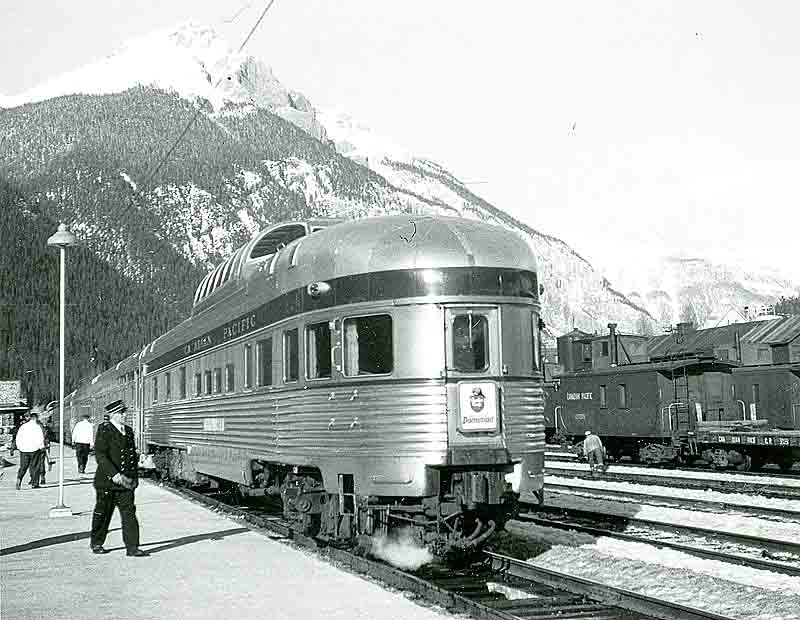
Contrary to much pessimistic advice, I easily found work in an architects’ office in
Vancouver, where I worked for about seven and a half months. There was absolutely no
working steam west of the Rockies on CPR or CNR. But in the small town of New Westminster,
about twelve miles up the Fraser River from Vancouver, were industrial premises which had
their own large, modern and nicely cleaned 0-8-0 shunter in normal use.
By October 1958, I was again getting itchy feet. I approached the skipper of the British
freighter King Malcolm which was docked in Vancouver, for a job as a deck hand to
Australia, and although at first agreeable, I think an experienced man he already knew
became available, so I was unlucky. Instead I bought a ticket for a voyage by P&O to
Sydney, Australia, but with a five week break in Auckland, New Zealand. The voyage by P&O,
on the Orcades to Auckland, was not quite as luxurious as that by Cunard’s Sylvania across
the Atlantic. Our first port of call was San Francisco, where I went ashore. The second
was Long Beach, port for Los Angeles. The distance between the two cities was probably
about thirty miles, which I travelled by the Pacific Electric Railway, once known as an
important interurban system in the area. Los Angeles suffered from its then common air
pollution, for which I think the word smog was originally coined. I found that my eye
irritation was such that I spent as much time as possible in air-conditioned cafes or
similar to avoid the uncomfortable stinging sensation. On return to the ship a little
before midnight, on a warm calm and moonlit evening I observed a USN aircraft carrier,
carrying many planes, silently moving across the dock to depart.
The voyage on Orcades continued to Honolulu, passing Diamond Head before docking by the
famed but visually insignificant Aloha Tower. I went ashore with friends and to a
restaurant on Waikiki beach, and was very impressed with the inexpensive prices. Later
we went to a car hire office, with the intention of picking up the car early in the
morning, and doing a round trip of Oahu before returning to the ship for departure at
around 1500hrs. The car was a 1958 model Chevrolet Impala convertible. When we
collected the car we at first went for a short ride, with me sitting on the folded down
fabric roof with my feet on the back seat, on the left hand side. I rested my left hand
in such a position that when the huge single door closed, it squashed the tip of the
index finger of my left hand, and split the fingernail in a manner which has never cured
to this day. The trip by car was abandoned, I was taken back to Orcades, and the ship’s
doctor cured the problem of the enormous pressure beneath the nail by piercing the
centre of the nail with a red hot needle, thus allowing the pus the spurt out. Fast
forward exactly fifty years, and I next saw exactly the same model Impala in the Plaza
in Cienfuegos in Cuba, where I photographed it with a pretty girl, before showing her my
still split finger.
The leg of the journey from San Diego to Honolulu, and the next leg therefrom to Fiji,
were by far the longest of the voyage. A curious incident happened somewhere in mid
Pacific. I was standing on an upper deck, forward to the bridge, on a calm sunny day
with good visibility, when, hull down on our northwestern horizon I spotted a strange
object, probably about fifteen miles from us. Its silhouette was such that at first I
did not understand what it was. It seemed to be moving in the same direction as we were,
but more slowly, and slightly converging with us. I watched it for fifteen minutes or
more, in the company of an English couple resident in Australia, but who had been to UK
for their first return holiday. At last I decided what the object was. It was a large
USN cruiser, being replenished at sea by a tanker in parallel. The two ships became
individually identifiable as such once they became more broadside to us. Pleased with my
own powers of deduction, I proudly proclaimed my identification of the object. The
response of the English girl was intended to deflate me. She said “that’s not the sort
of thing you should say when you get to Australia, because it makes you sound too clever
by half, and you will not be popular”. Her words implied that Australians had an
inferiority complex which affected their response to anyone whom they thought to be of
superior intellect. I feel bound to say that during my frequent contact with Australians
in years that were to come, I never experienced a situation which proved her words.
Having called at Fiji, we continued to Auckland, where I disembarked. My uncle Percy
from the Falklands, with his wife Georgie from Goose Green and his children Brenda and
Bill had, like many Falkland Islanders in this era, emigrated to New Zealand, about a
year earlier. They had invited me to stay with them in Auckland, which I did for a few
days. But then I, with a Canadian girl I had met on Orcades, did a round New Zealand
tour by hitch-hiking for four weeks before returning to Auckland. We travelled
extensively in both the North and South Islands, excepting for the area of North Island
north of Auckland. At that time, although there were small pockets of electrification,
diesels had made little headway in replacement of steam power on the railways. I did
observe steam locomotives in many locations, but at this time this was not sufficient to
enable me to fully regain my enthusiasm.
In mid December 1958 I resumed my journey, this time by the P&O liner Oronsay from
Auckland to Sydney, a voyage of about two and a half days. We entered Sydney Harbour
through the Heads, past the site of the yet to be developed Opera House, beneath Sydney
Harbour Bridge, and immediately turned left to moor at the quay in Pyrmont. The dock
opposite was served by railway lines, and standing there was a NSWGR 1900 class 0-6-0 of
about 1877, on dockside shunting duties (see below). This was shortly before Christmas
1958, and I was to remain in Australia until May 1960.
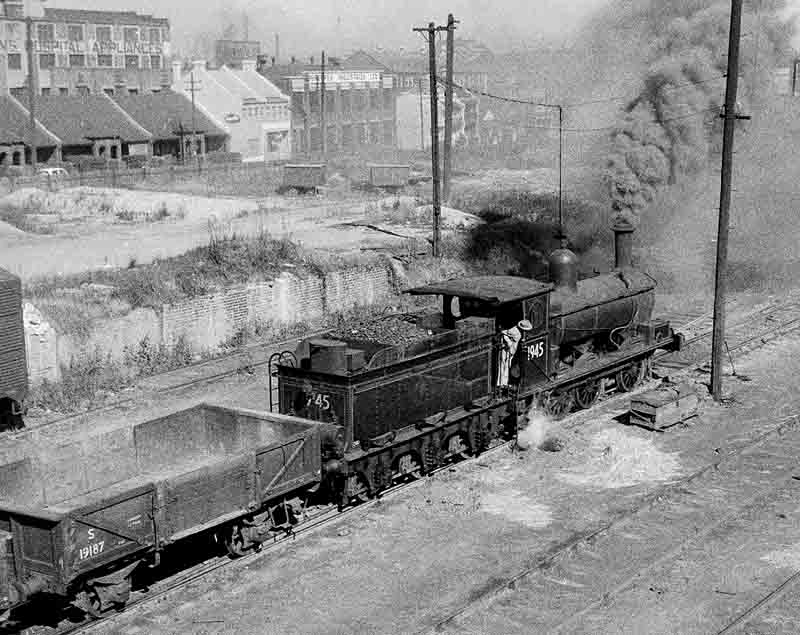
In an earlier section, headed “A Lull”, I referred to a lull in my railway enthusiasm,
relating to locospotting rather than interest in railways generally. But the enthusiasm
returned, engendered mainly by my visits to Australian railways, mentioned above, but not
described in detail in this volume.
I lived in Sydney for 17 months, during which I worked as an Architect, and also designed
and built my own house, the latter largely with my own hands. In this period I married
Mary, an Australian girl whom I had met on the voyage across the Pacific from California.
I left Sydney bound for Piraeus in mid May 1960, on route to England, the latter stage of
which journey would be overland by rail. I travelled on the liner Patris, by now in Greek
ownership, but being one of three similar vessels built for Union Castle Line in the early
fifties, probably Kenya Castle , for their England to East Africa service. This service
seems to have been discontinued as uneconomic due to airline competition, and the ships
concerned were sold. The first port of call was Melbourne, Victoria followed by Fremantle,
Western Australia. Close to where we were docked in Fremantle was a quayside railway yard
being shunted by five ancient Beyer Peacock 2-6-0s, probably of about 1890. I had not
known about these engines or their work, and it wetted my appetite for a further visit to
Australia.
Patris made the lengthy voyage northwesterly across the Indian Ocean and entered the Red
Sea, whereupon we stopped at Aden for a few hours. I thought it was time to buy a new
camera. New as in unused, that is. I bought a Rolleiflex. It was a disaster. A second
experience on the Folkestone Harbour branch some weeks later, by which time ex GWR pannier
tanks had bumped the SER R1 class as motive power, was a great disappointment, and lead to
my continuance of the use of older cameras.
We proceeded northwards in the heat of the Red Sea and stopped at Suez, from which a
tourist trip was arranged for passengers by bus to Cairo, and onward to reboard Patris at
Port Said. I had looked forward to the voyage through the Suez Canal, and was
antipathetic towards the wishes of my companion to do this bus trip. But do it we did.
We went to the Pyramids, which in those days had not been cluttered with the anti-climbing
barrier which now exists, and many people were climbing the stepped surface towards the
top of the main pyramid. I wanted to do likewise, but my companion refused. On the
evening of the following day, the bus took us to Port Said, but we paused in the darkness
at the side of a canal for a pee stop. The night was silent with only a very slight
breeze, but I became aware of a gentle rustling noise. It was a magnificent dhow, under
full sail, making her almost silent way along the canal.
Patris departed from Port Said very late that evening, and a day was spent traversing the
eastern Mediterranean, in sunny but much cooler weather than the Red Sea. We arrived in
Piraeus early the following morning. Yet again the subject of sold off liners came to my
attention, as one of the Royal Mail “Highland Boats”, of the class of five which included
Highland Princess and Highland Chieftain, upon which I had travelled in 1939 as related
earlier, was laid up. She was positioned in such a way that I could not read her name.
Piraeus is the port of Athens, the latter city in which we stayed for a couple of days,
before taking a train to Salonica, the second city of Greece. The journey of about 350
miles took all day from about 1000 onwards. The route is partly flat, but includes
ferociously graded mountain sections. The locomotive was one of the huge Breda built
2-10-2s which Italy was apparently inveigled into supplying to Greece as WW2 reparations, (pictured below).
It seemed to perform satisfactorily on the day of my travel, but it did not surprise me to
learn later that these locomotives, the size of which was far beyond the Italian
experience in steam locomotive design, had been withdrawn after a short lifespan.
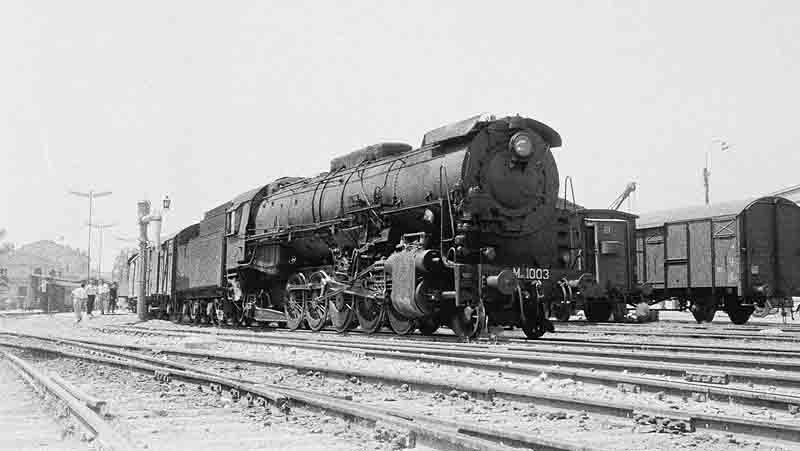
My return to UK was in about mid June 1960, so I had been away for two years and four months. I bought an almost new Mark 2 Ford Zephyr car. At that time, which was about a year before the evolving political situation resulted in the construction of the Berlin Wall, it was possible to visit Russia by driving one’s own car. In about mid July 1960 I set off with friends for Moscow, stopping in Berlin for a couple of days en route. Then we proceeded through the Brandenburg Gate into East Germany, thence into Poland at Frankfurt on Oder and onwards to Warsaw. Thereafter we continued into Russia at Brest-Litovsk, and reached Moscow via Minsk and Smolensk. During this journey little was seen of steam locomotives other than a Kreiglock on an eastbound freight in Poland, a standard Russian 0-10-0 shunting in Brest, and a narrow gauge 0-8-0 on a childrens’ railway in Moscow. We then drove north to Leningrad, and entered Finland near Vyborg, which had been part of Finland until annexed by the USSR following the Finnish-Russian war, which was fought during the early part of WW2.
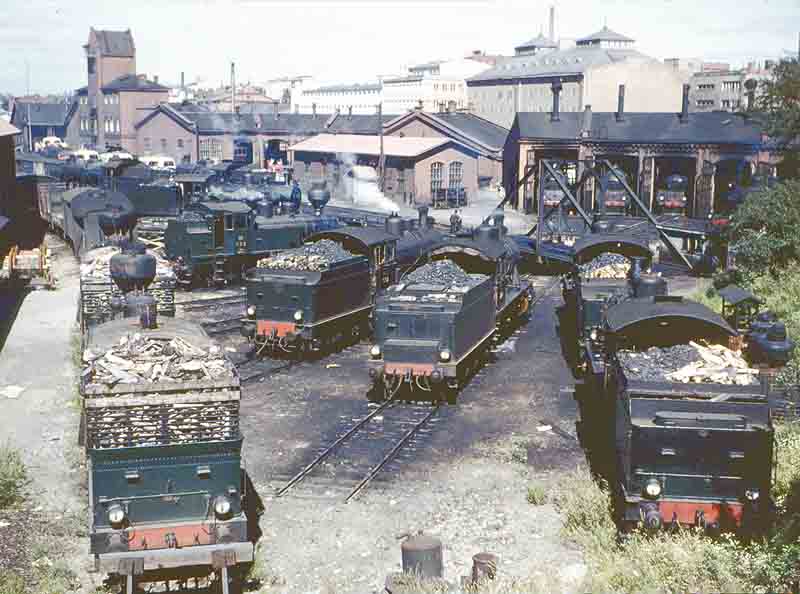
The Finnish part of our journey was by far the most pleasant. Finland is a clean country of great visual appeal, and is of the western ethos, in contrast to the drab scene which we had found in East Germany, Poland and Russia. Furthermore, the quite extensive railway system was still operated mainly by steam power. We travelled to Helsinki and several smaller towns, including Lahti and Tampere (seen above), in which steam was still predominant, before departing from Turku, otherwise known as Abo, on the west coast. We took a ferry to Stockholm, and having driven across Sweden, entered Norway for the final part of our journey. Some steam was observed on Norwegian railways with 4-6-0 number 346 standing in the shed yard at Otta (seen below), but I had little opportunity for photography. We departed from Bergen on a late afternoon sailing to Newcastle, where we arrived the following morning. At the quay where we ended our journey was an ex NER electric locomotive!
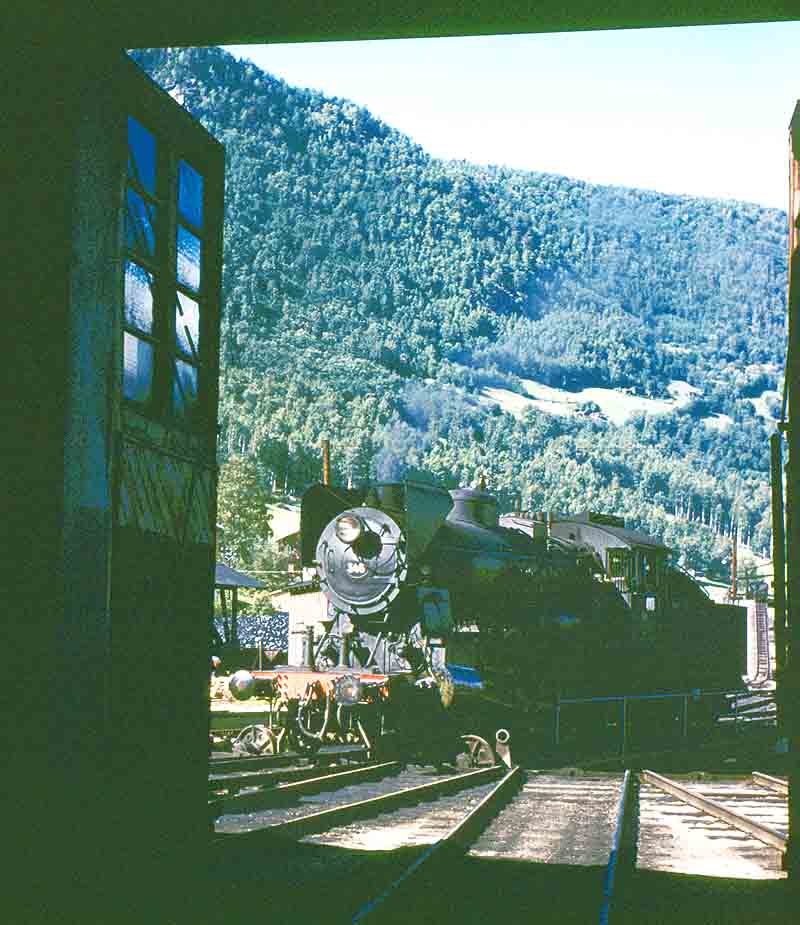
After my return to England in about mid August of 1960, I found accommodation in Hendon,
London NW9, and employment as an architect with a company in Grays Inn Road London WC1.
It was necessary for me to commute to work daily. This meant walking to Hendon station on
the Midland main line, and taking a suburban dmu to St Pancras, before walking about half
a mile to the Grays Inn address. When I started this daily travel, probably in the second
week of September 1960, the main line express services remained steam hauled, with
“Britannias”, Black 5s, “Jubilees”, and rebuilt “Scots”. But during the period of about
seven months that I was working in Grays Inn Road, and travelling to St Pancras,
dieselisation of the express trains commenced, and seemed to be largely completed within
this period, the locomotives used being of the “Peak” class.
1962 was the year, when my first daughter, Jennifer was born on 1 June. She was followed
by the second, Wendy, on 27 December 1963. Both are now following professional careers,
Jennifer being an Architect and Wendy being a Surveyor.
The reason I gave up my employment with the company in Grays Inn Road was that I wanted to
commence architectural practice on my own account, and this I did in late April 1961,
under my own name of Gerald Dixon. At a later date, after which I had completed a
post-graduate Town Planning course, the practice was renamed Dixon Architects, Chartered
Architects and Planning Consultants. This did mean that for a time, railway visits beyond
London had to be curtailed, as due to necessity I had to give time to creating my intended
career. However, in this period I made fairly frequent visits to London mpds, and also to
my mother’s house in Ashford, Kent. On the latter visits I was able to engage in limited
photographic activity of Southern Region Eastern Section steam activity, or inactivity, in
the final year of steam before the electrification of the Mid Kent line and associated
branches was completed, and steam activity completely ceased.
In late 1963 I bought a building site for a single house in London N20, which I built in
the 1964 to 1965 period, and in which I have lived to date, except for a short period in
the mid 1970s. The first thing I did after moving in was to go on a day trip to Bushbury,
where on shed I did for the last time see a rebuilt “Patriot”, and to other Black Country
mpds. As for the house, it was for the first nine years of its existence also my office,
to which it reverted from 1993 to date.
In the late Spring of 1963, a London client wanted me to inspect a house he owned in
Branksome, in which an elderly female relative of his lived. I decided on a day return
trip, travelling on the Bournemouth Belle. At that time it was still running to
Bournemouth West station, which I think closed in September 1966 coincident with the
closure of the Somerset & Dorset Joint Railway. It was on that day
that I became acquainted with the Bournemouth West triangle, two sides of which were upon
quite extensive viaducts, built in a cream-coloured brick, and looking much cleaner than
such viaducts in other British urban areas. The station was completely demolished, and
the area of the approach tracks has now for many years been occupied by an important urban
road which I have frequently used, as well as the train washer.
Below : West Country class 34044
Woolacombe crosses the mainline viaduct near Bournemouth West on 29 March 1967.
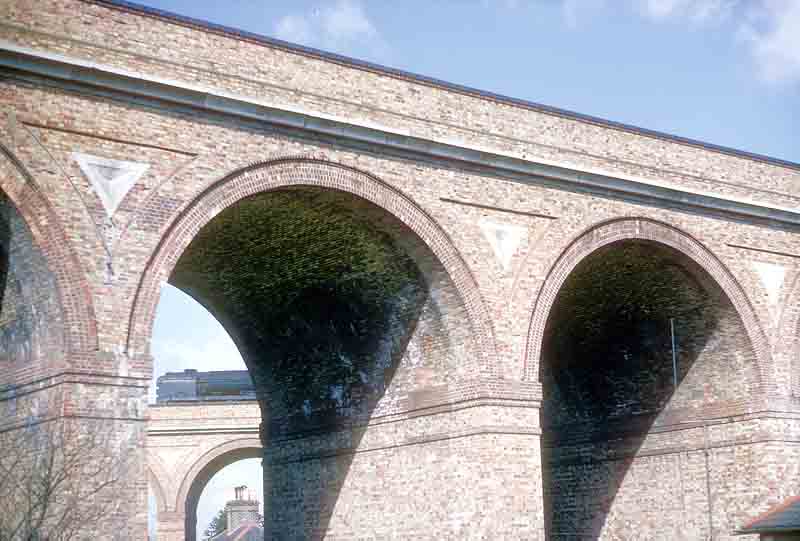
In the 1962-1964 period I joined the Warwickshire Railway Society on many of their
intensive mpd visits, as well as commencing my own longer distance visits. Thereafter,
my own activities in Britain increased enormously, until steam on BR came to an end in
early August 1968.
There were only two exceptions to the above. The first was in April 1967 when I made a
visit to New Zealand and Australia, the latter on behalf of clients, but where I took full
advantage of the situation to photograph the steam scene as it then was in the South
Island of New Zealand, and in New South Wales, South Australia and Western Australia.
The second exception regarding overseas visits, referred to in the previous section,
concerned a visit to West Germany. This West German visit was solely to follow my railway
interest. It was the only visit I made which was contrary to my policy of avoiding
overseas visits until BR steam had finished. At least by this time my architectural
practice had reached a temporary plateau, and a short visit to West Germany was not a
problem. So when a small group of enthusiasts invited me to participate, I was happy to
do so. The visit in June 1968 was only six weeks before the demise of BR steam, and was
to southern West Germany, including the Black Forest area. It was few days spent in
excellent weather conditions, much of it in almost perfect rural scenery. P8s were still
very active on local passenger trains. At the time I found the visit very pleasing, but
after a short look at the transparencies on my return to UK, they remained untouched in
their boxes until September 2015! When I did inspect them again, I was amused at the
almost clinical perfection of the country landscape and the trains that ran in it, all of
which supported the normal British view that Germans are boringly meticulous in most of
the things that they do. I made one more visit to West Germany for photography in 1970,
and one longer visit to East Germany in 1982.
Below : Former KPEV class P8
4-6-0 number 038 2242 heads a train for Esslingen away from Horb station.
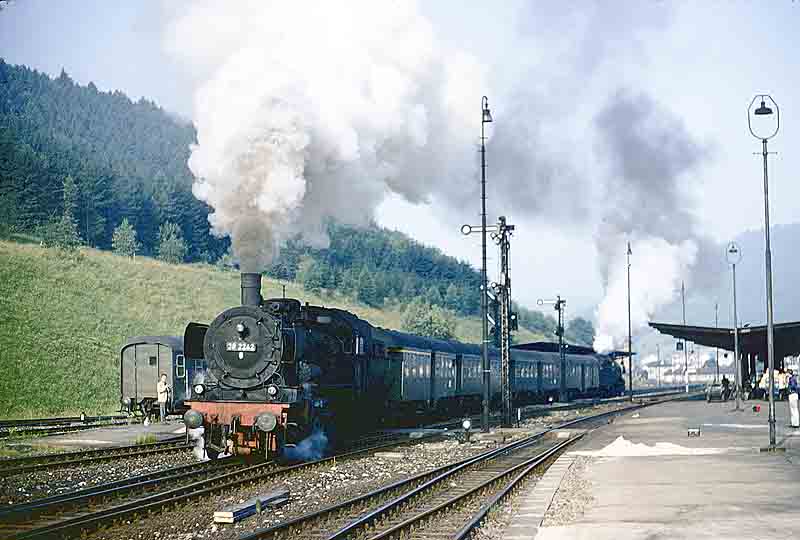
As steam came to an end on BR in early August 1968, it had gradually been confined to the
Lancashire area. I suffered an embarrassing inundation of my car in Morecambe Bay, on the
last day of steam working. I wrote furthermore:
“As we worked to retrieve my car from Morecambe Bay, we could hear one of the very last
steam workings on BR, as a Carnforth-West Cumberland line parcels train worked hard in the
Kent Bank area, miles across the Bay. It was a sad and unexpected finale to real working
BR steam.”
GERALD DIXON October 2015

